Pyramids and Pyrotechnics:
History and Festivals in Mainland Mexico
December 2023 to March 2024
On our annual winter getaway we spent two months in Mexico, returning to some favorite places, and discovering a few new ones. Highlights this year included the ancient pyramids of Teotihuacán, and many festivals, such as a week of Carnival revelry and tradition in Pátzcuaro.

Click here to learn about our Promaster van.
7755 miles and 75 days (55 days in Mexico). Scroll to the bottom for cost information.
Heading South
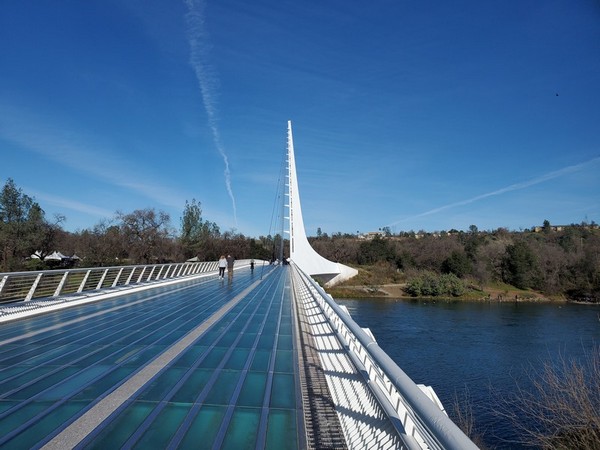
It was a warm, sunny New Year's day at the Sundial Bridge in Redding, California. We like to stop here to stretch our legs on the Sacramento River trail.

Twenty feet tall and 40 feet long, this eye-catching roadrunner sculpture at the Scenic View rest area near Las Cruces, New Mexico, is made out of discarded materials such as tires, shoes, and scraps of metal.
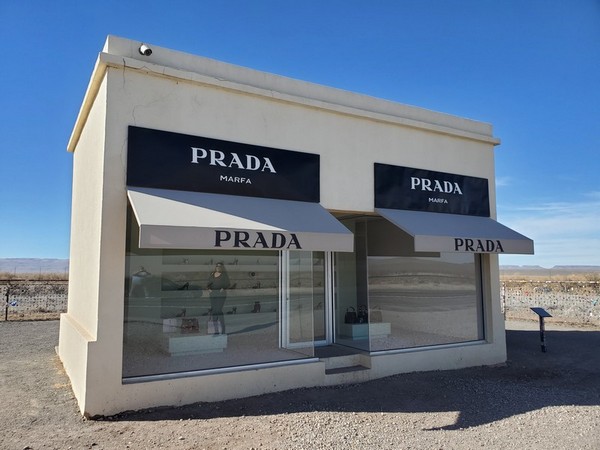
Highway 90 near Marfa, Texas, is a desolate and lonely stretch of road through the desert. So when you see this Prada store, you do a triple take. Turns out it's an art installation! (In case you were wondering, the woman reflected in the window is real, not a mannequin.)
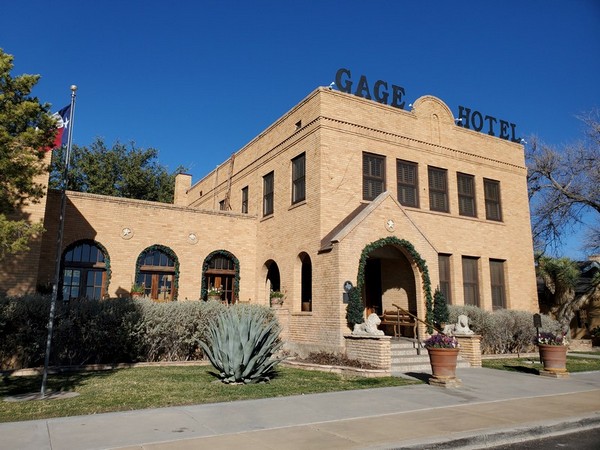
The historic Gage Hotel, opened in 1927, is the economic engine of the charming little town of Marathon, Texas. Guests are mostly Texans and foreigners. It's a "bucket list" destination for many Texans.
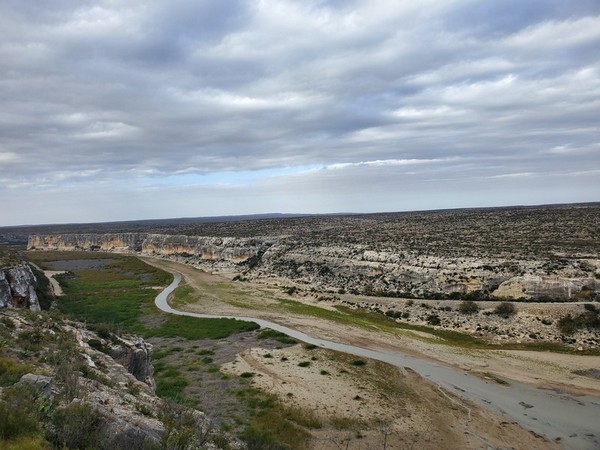
It was very windy on the Pecos River near Del Rio, Texas.

The cheapest gas we saw on our trip was in Del Rio, Texas.
MEXICO
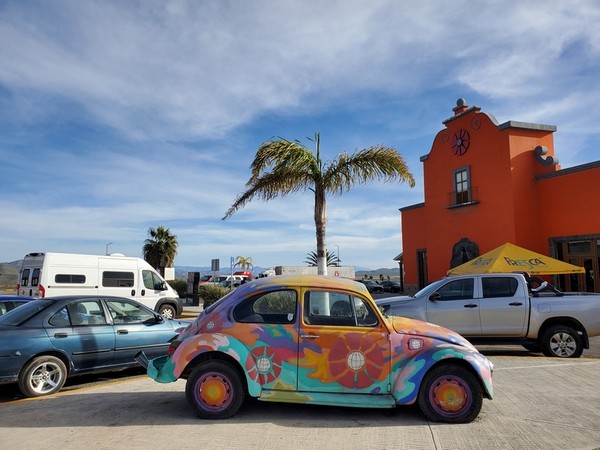
We crossed the border in Eagle Pass, Texas. It took about seven hours to get to this rest area north of Matehuala, where we parked for the night. It has restaurants, a gift shop, gas station, and clean restrooms. It's a five-hour drive from there to San Miguel de Allende.
San Miguel de Allende, Guanajato
It's a 12-hour drive on a good road from Eagle Pass to San Miguel.
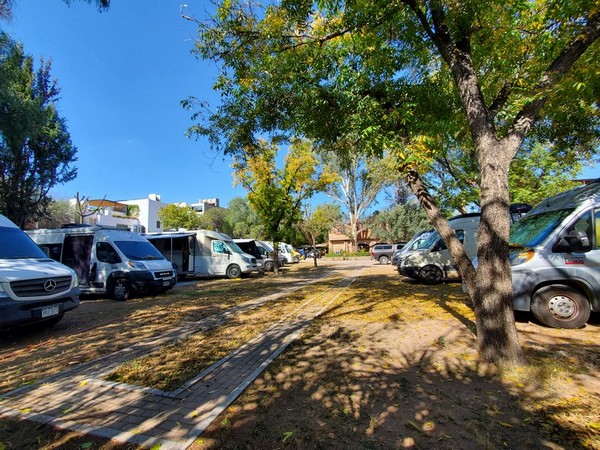
The San Miguel campground is a quiet oasis right in town, and we can walk to everything. It holds up to 12 small rigs. There were people from the USA, Canada, Australia, Germany, and Switzerland. We spent two weeks here.
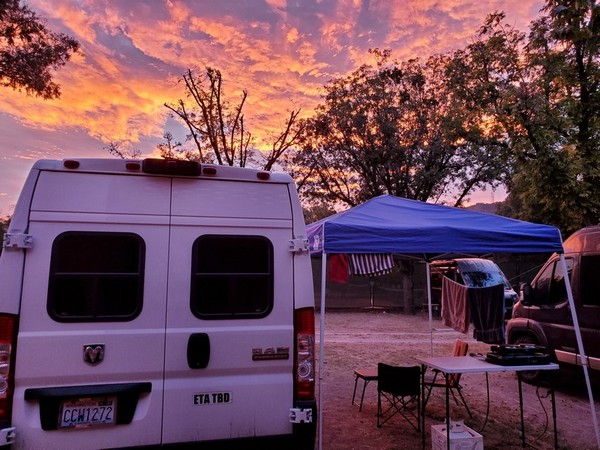
Sunrise at our campsite in San Miguel de Allende
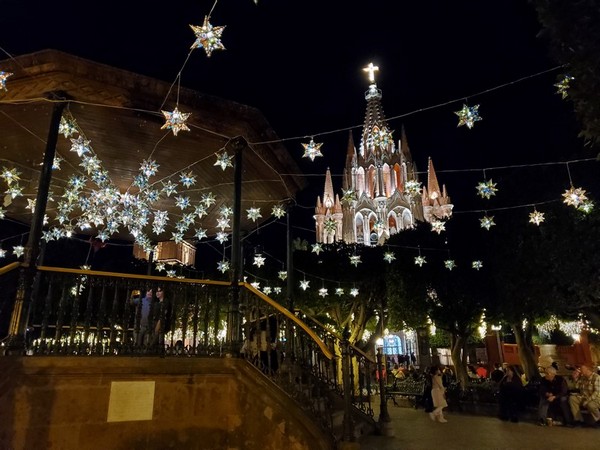
The main plaza in San Miguel was decorated with illuminated tin stars for the holidays. The pink stone church looks out of a fairytale.
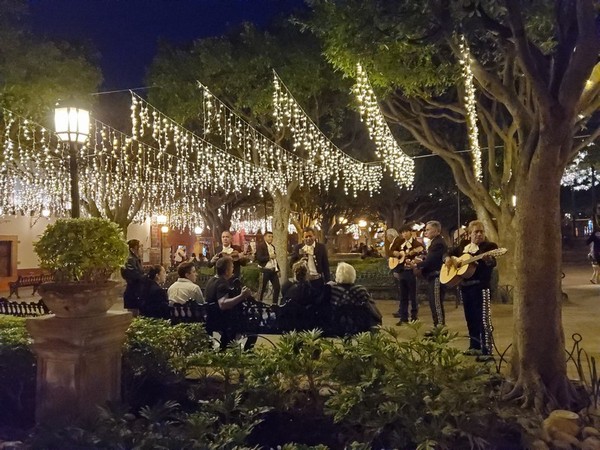
Mariachi bands serenade for tips in the main plaza in San Miguel de Allende on weekend nights. Each group designs their own silver-studded outfits.
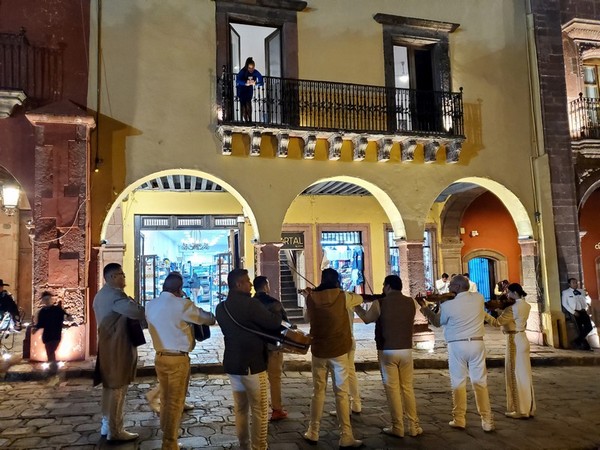
This mariachi band was serenading the young lady on the hotel balcony above them. The photo does not capture their Motown-style synchronized dance moves!
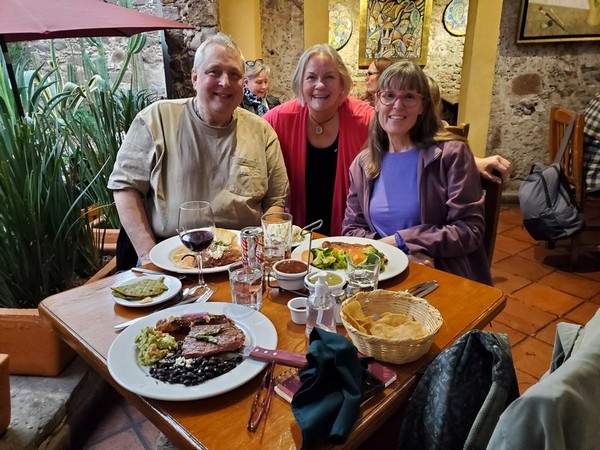
My Peace Corps friend Debbie was spending a month studying Spanish in San Miguel (her first visit) and we met her for dinner at a beautiful Mexican restaurant.
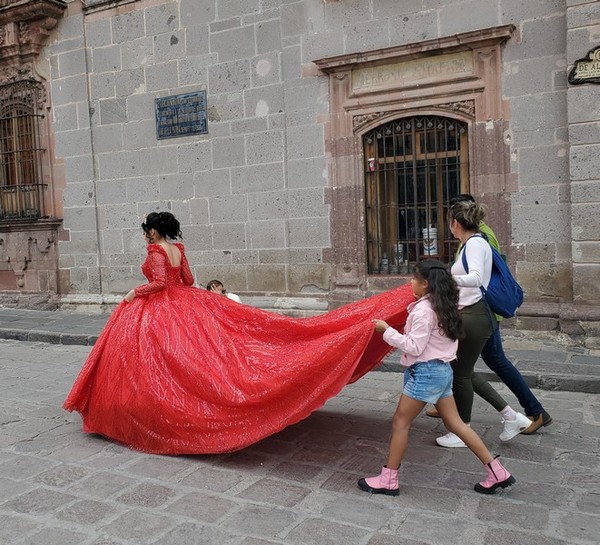
Wealthy families spend big bucks on quinceañeras (15th birthday celebrations), which can include elaborate dresses, professional photo shoots, and enormous receptions.
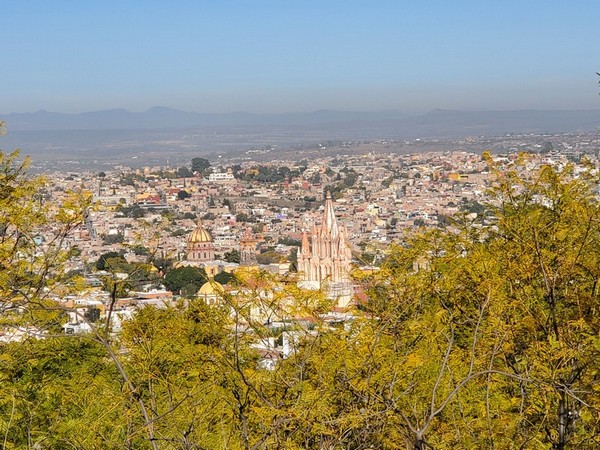
San Miguel is in a high desert at 6000 feet. The haze in the air is dust; the area is in a prolonged drought.
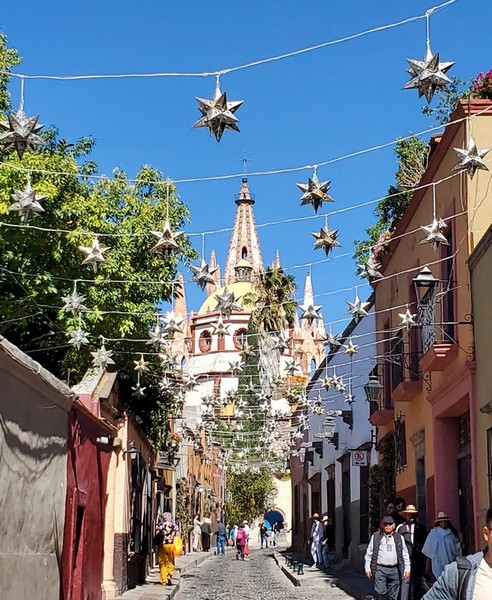
Holiday stars festooned the picturesque cobblestone streets.
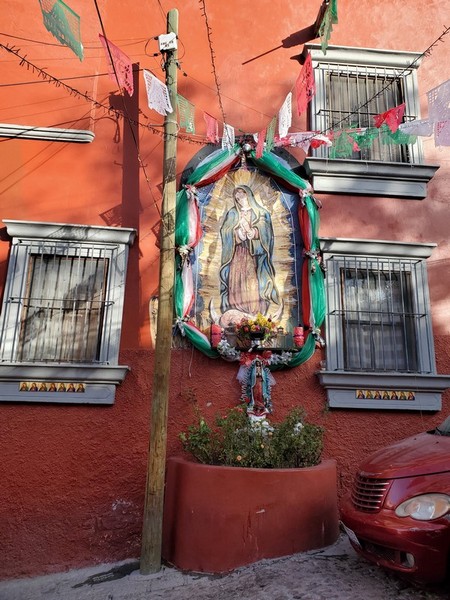
Shrines to Our Lady of Guadalupe are everywhere in Mexico. She is considered the patron saint of Mexico, and her image is associated with everything from motherhood to feminism to social justice.
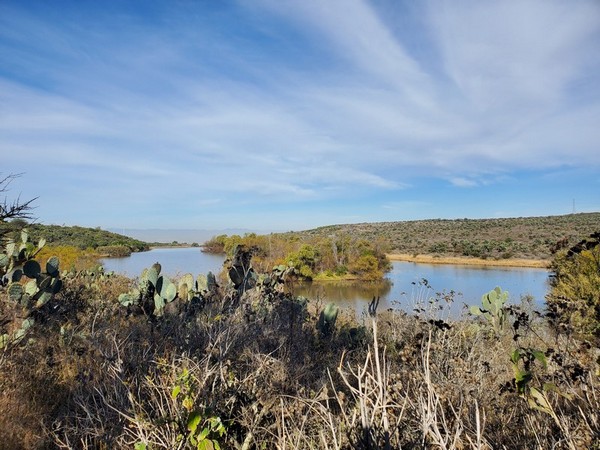
The San Miguel botanical garden (El Charco del Ingenio) is an oasis of calm and green on a hill above town. The reservoir is a haven for migrating waterfowl.
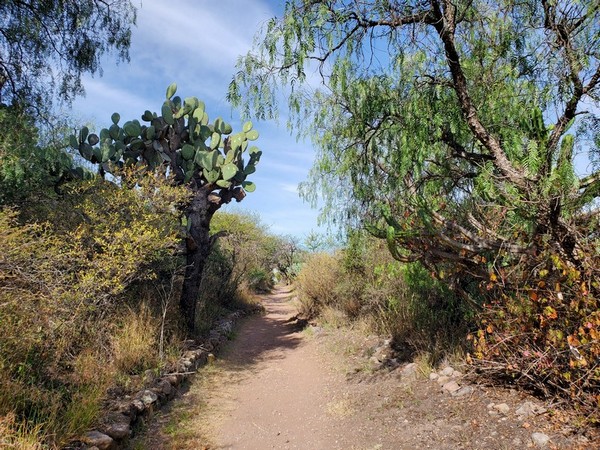
Trails wind along the reservoir and through a canyon.
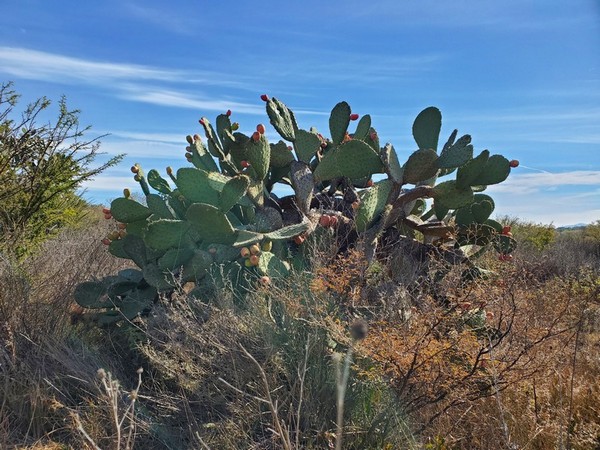
The edible fruits of the prickly pear cactus are called "tunas."
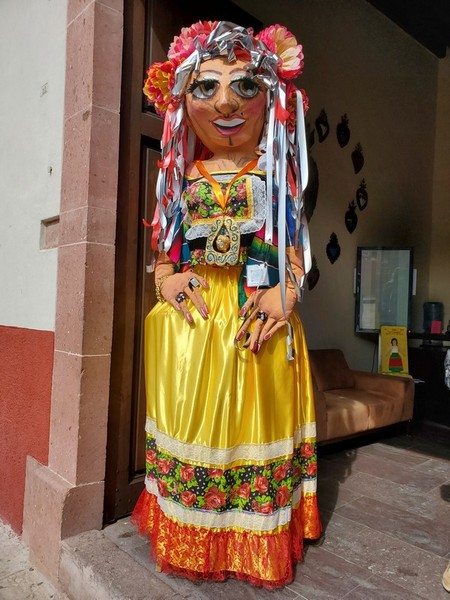
Tall puppets called mojigangas are popular at parades and festivals. The heads are fashioned from papier mache. A wooden frame and a small opening allow a person to stand inside and power the puppet.
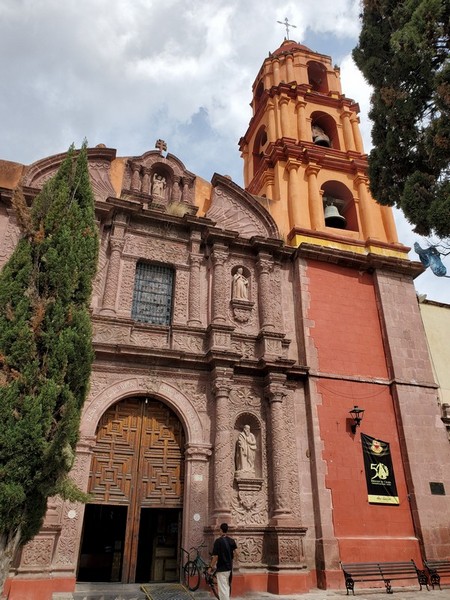
One of the many beautiful old churches in San Miguel. This one dates from the early 1700s.
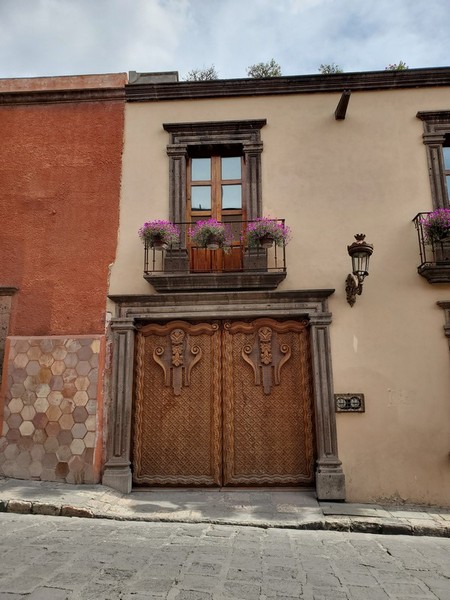
Whole books have been written about the stunning wooden doors of San Miguel. Starting years ago, wealthy foreigners and Mexicans have helped restore and preserve the town's architecture.
Allende's 255th Birthday Celebration
Independence hero Ignacio Allende was born in San Miguel de Allende, and the town was named for him. Each year the town pulls out all the stops for a multi-day birthday celebration.
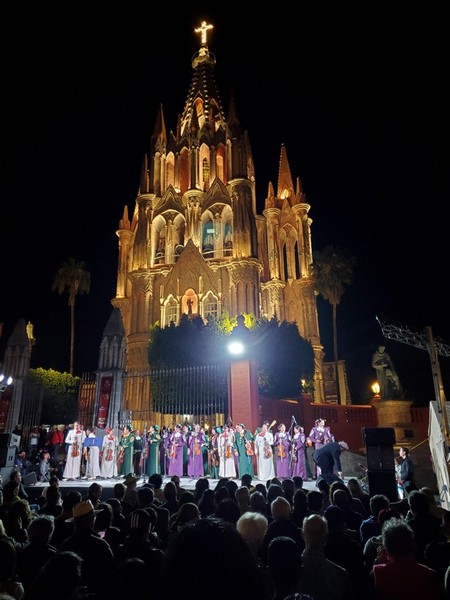
On the first night, a "super group" of women's mariachi bands from all over the state of Guanajuato performed in the square.
Women's mariachi supergroup singing "Mexico Lindo." Their outfits had sparkles, and matching boots.
Day two of Allende's birthday celebration featured Ballet Folklórico, folk dances representing Mexican regions, folklore, and history.
Day three featured a band with an amazing trumpeter. A long time ago, bull fights were held in this plaza. While I don't like bullfighting, I enjoyed this "music of the bulls" concert. Two impressive bull sculptures were brought in for the occasion. The iconic church is a stunning backdrop for a concert.
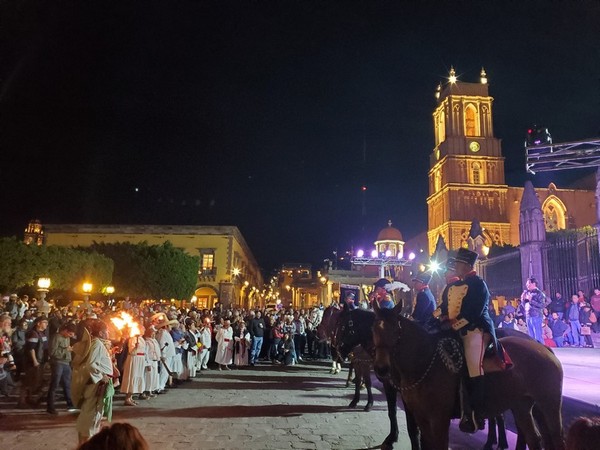
The Saturday parade was a historical reenactment of Allende leading a peasant uprising against the Spanish, torches and all.
San Miguel torch parade
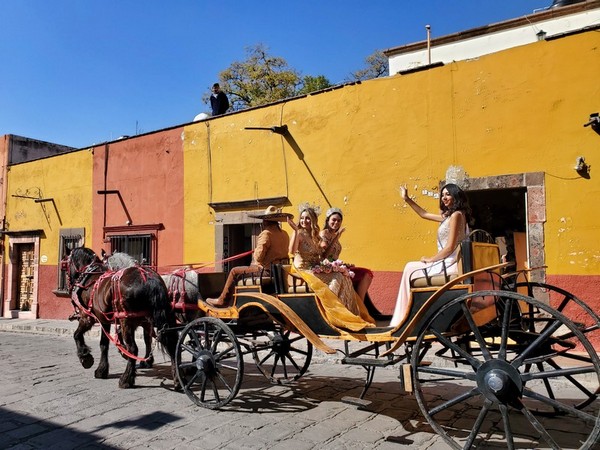
On Sunday there was another parade, with at least a dozen marching bands, costumed insurgents on horseback, and several carriages with Miss San Miguels.
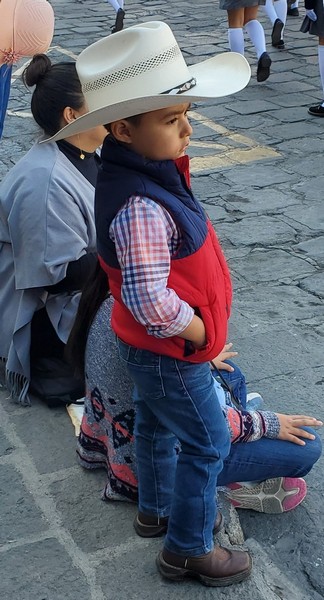
I wonder what this dapper little fellow was thinking about as he watched the parade?
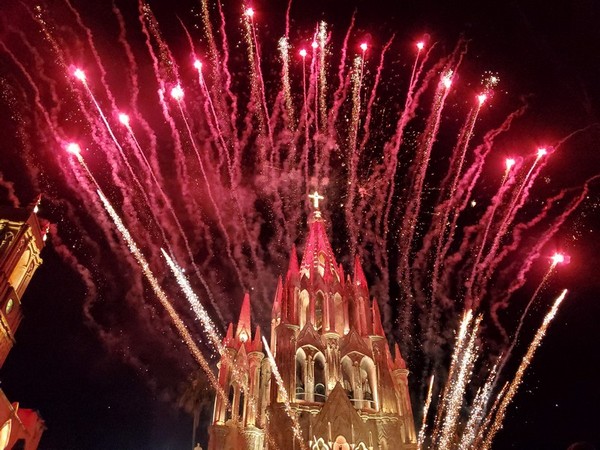
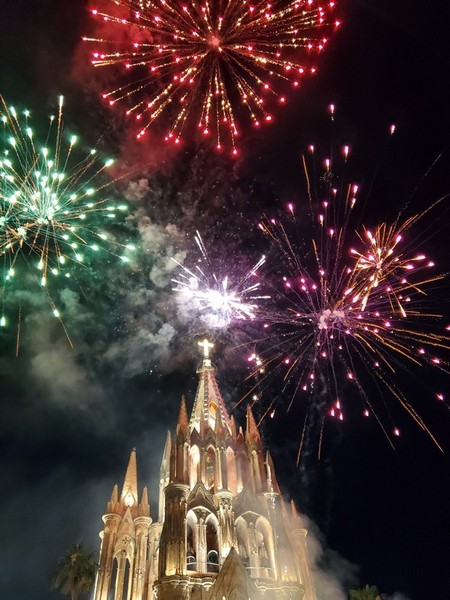
The grand finale of Allende's birthday festivities was a spectacular fireworks display!
Day trip to the Santuario de Atotonilco
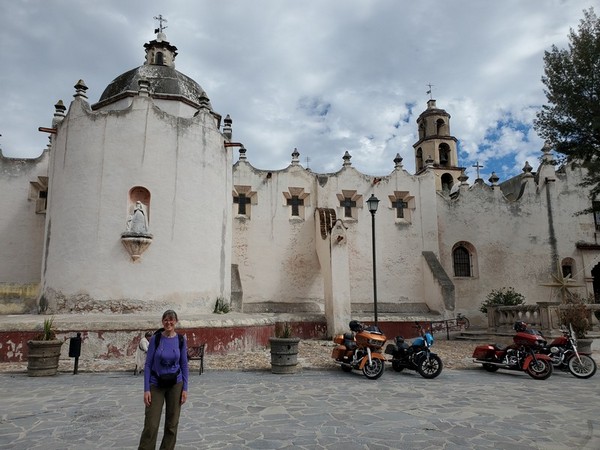
The Santuario de Atotonilco was built in 1740. This UNESCO site draws people from all over Mexico and the world to see the gorgeous Baroque murals that have given it the name "the Sistine Chapel of America."
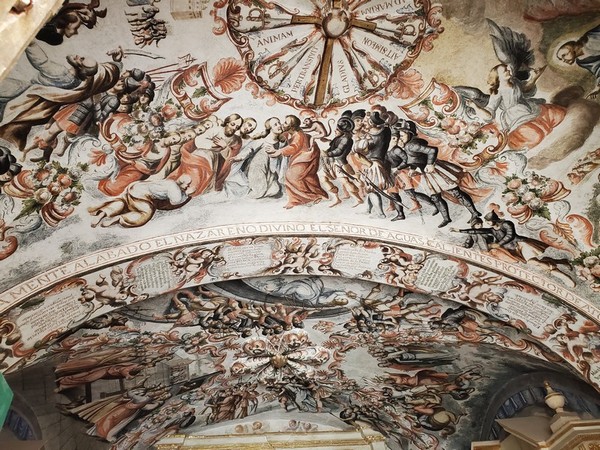
The entire ceiling is covered in detailed frescoes like this.
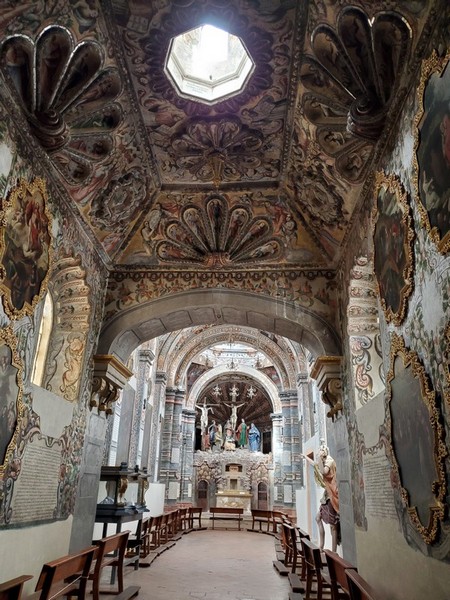
One of the side chapels
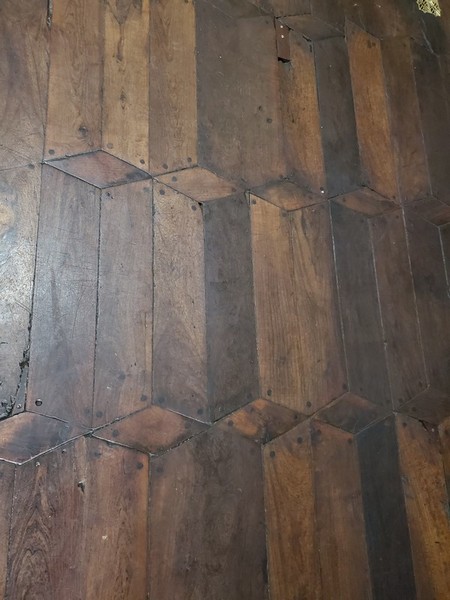
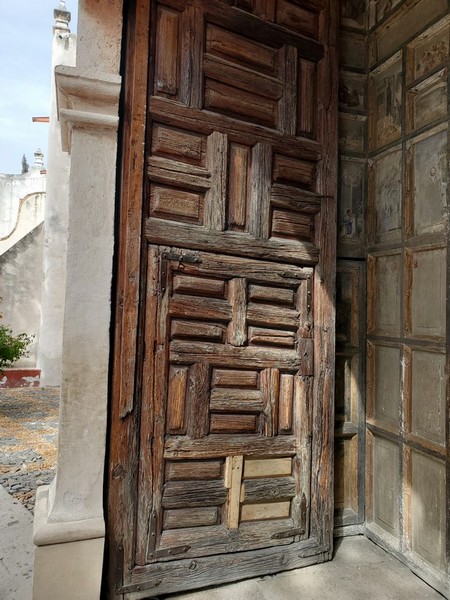
Pegged wooden floor (left). I think the door is original, which means it is 300 years old...
Village Tours
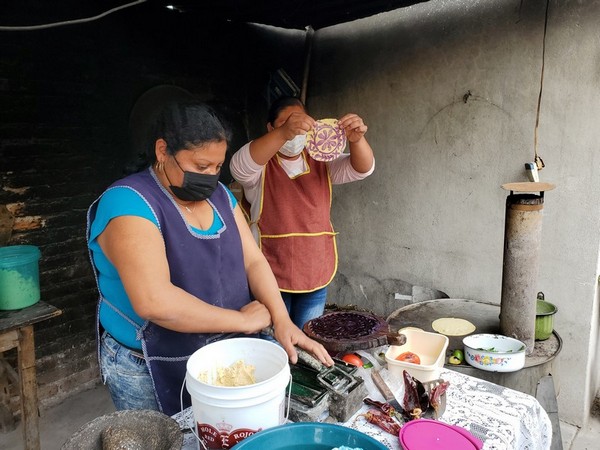
I went on two village tours. The proceeds help rural women support their families and communities. On the first tour, the women showed us how they prepare corn and make decorated tortillas for special occasions. The purple dye is made from an herb and rubbed onto a wooden stamp with a corn cob.
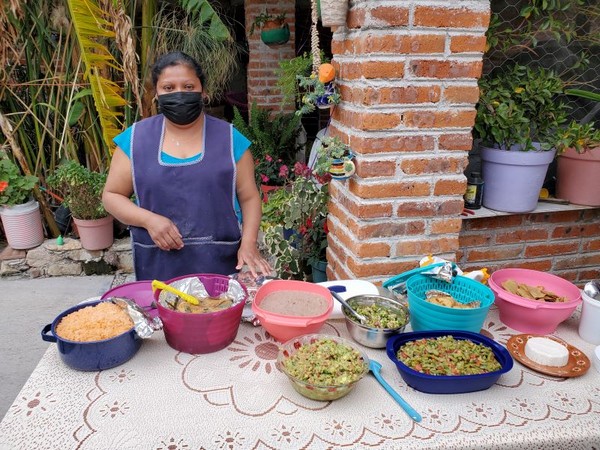
They fed us a delicious lunch of chile rellenos, rice, beans, cactus salad, tortillas, quesadillas, gorditas (thick, filled tortillas), queso fresco cheese, guacamole, potato patties, pico de gallo, and salsas. Beverages included guava, hibiscus, and cucumber-lime juices. Dessert was pumpkin cooked in sugar water.
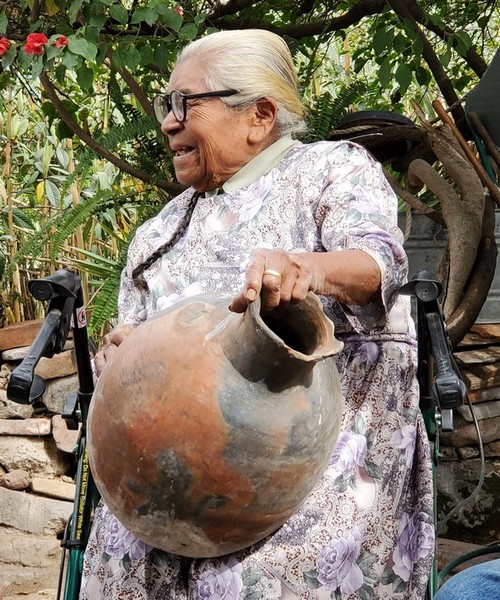
Maria is 91 years old. She had 11 children, but only five are still living. When she was young, her family made a living making clay water jars, tying them onto donkeys, and taking them to sell in San Miguel de Allende. Then the government relocated them and built a reservoir, which covered the clay, and their village. She is holding a jar she made 60 years ago. It's the last one she ever made.
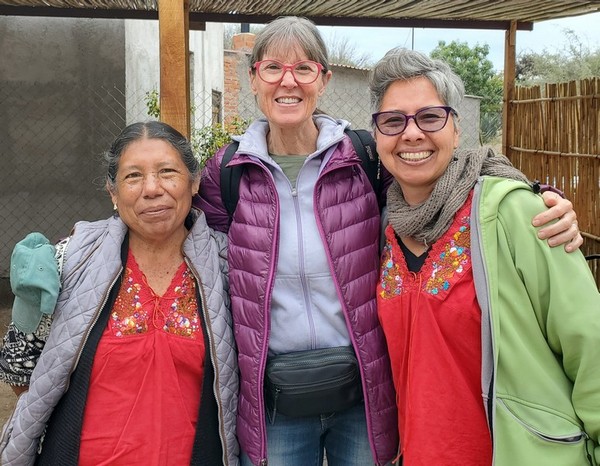
The second village tour was led by my friend Rebecca (right). She lives in San Miguel and works tirelessly to help migrants and underserved people. We went to a small Otomi community near San Miguel, where the women have formed a cooperative to preserve local plant knowledge and make plant-based medicinal and health care products. They served us a delicious meal, and we learned about the history of their community. (She and Ana Maria, on the left, coincidentally wore the same shirts!)
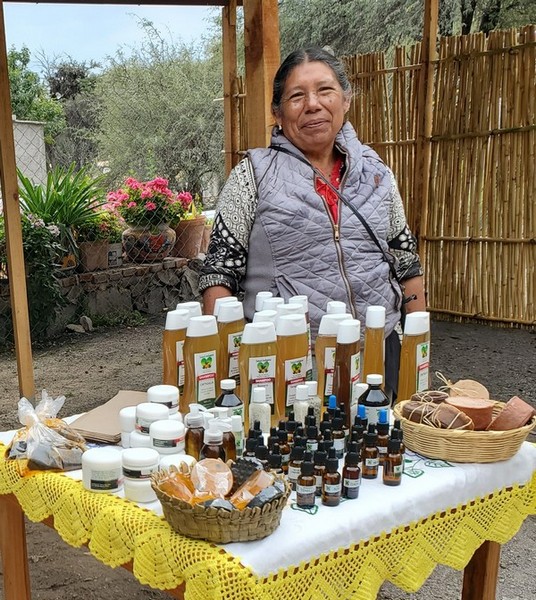
Ana Maria with some of the products the women make and sell: soaps, shampoo, creams, oils, and tinctures.
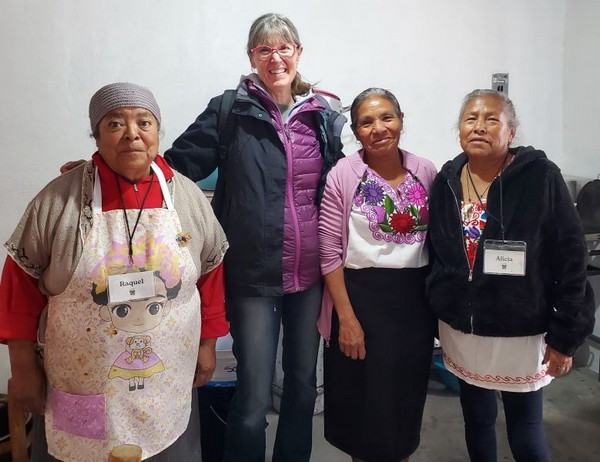
Some of the enterprising women of the Salud Indigena (Indigenous Health) cooperative.
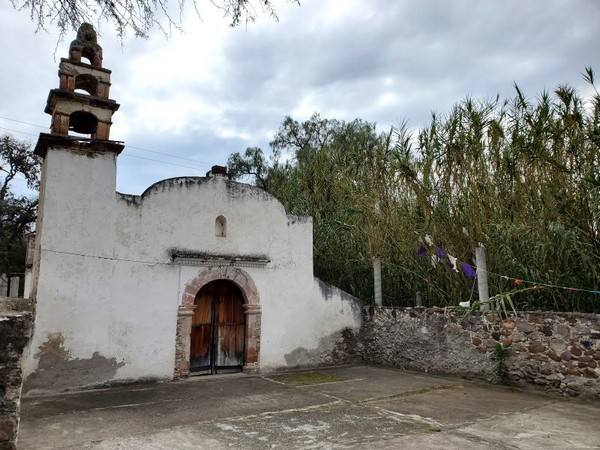
Their ancestral land was taken by the Spaniards and the women's ancestors became workers on a hacienda (a private estate). After Mexico's independence from Spain and the Civil War, some of the land was given back to the community. Indigenous people have few rights, however, and many live in poverty. The old hacienda church from 1874 is now used for local ceremonies.
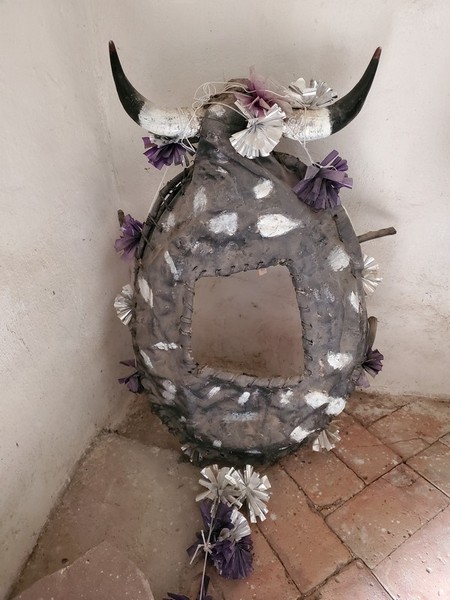
Mexican Catholicism is interwoven with indigenous beliefs and rituals. This "fertility" bull mask is probably 100 years old. It is worn during spring planting ceremonies.
Teotihuacán, Mexico
Teotihuacán was Mesoamerica's greatest city, an ancient metropolis with huge pyramids.
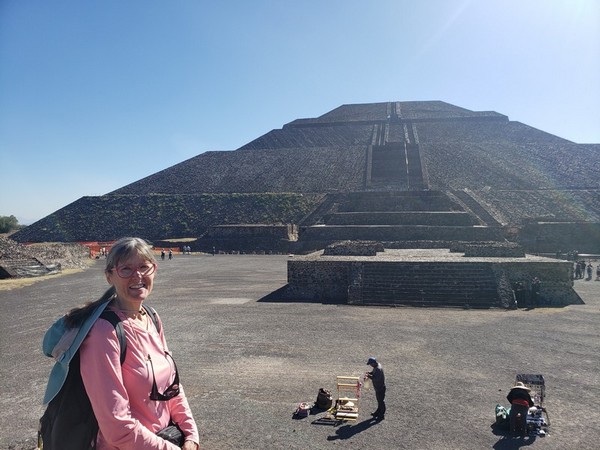
The Pyramid of the Sun (built in AD 150) is the world's third largest pyramid (Egypt's Cheops is the largest, followed by Cholula in Mexico). There was once a temple on top of this one. To help preserve the pyramids, you are no longer allowed to climb them.
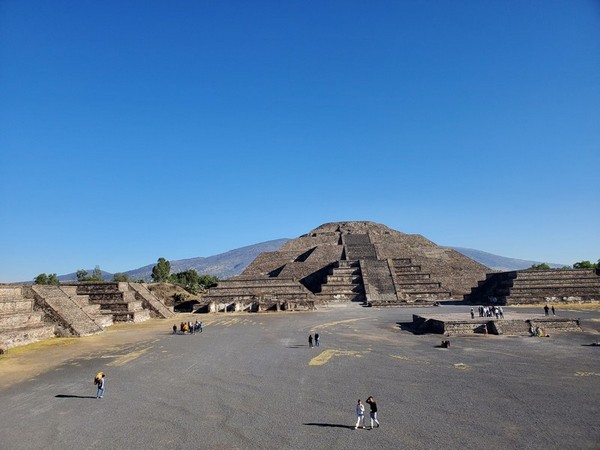
The Pyramid of the Moon dates from AD 300.
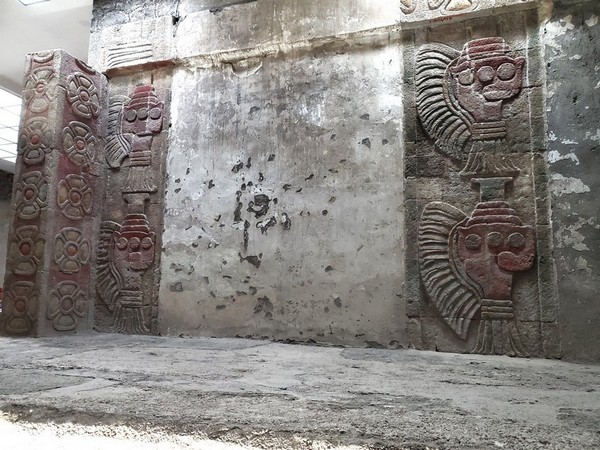
Stylized conch shells carved into a stone wall. Conch shells denoted status and spiritual power, and were blown like trumpets at ceremonies.
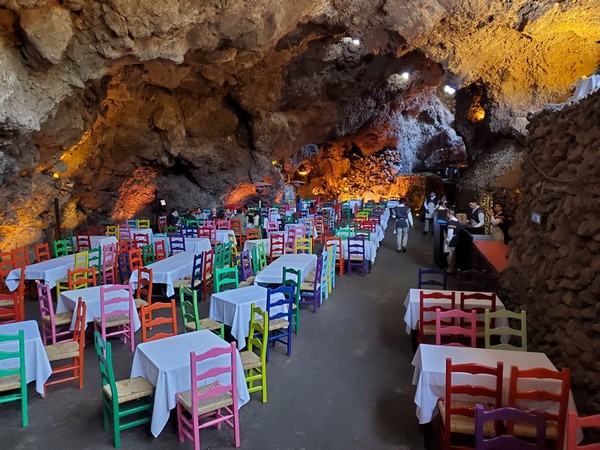
Looking for lunch, we stumbled on this magical restaurant in a grotto near the pyramids. Local legend says that the grotto is the birthplace of humanity.
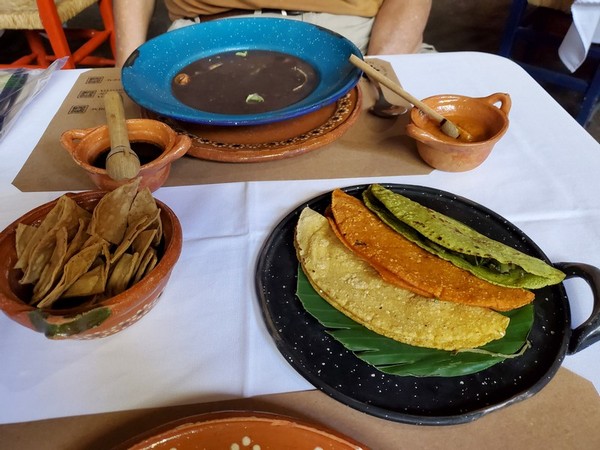
The food was delicious. We had corn and bean soup, plus quesadillas filled with mushrooms, cheese, sautéed onions, and wild greens. Each tortilla is made from a different color of corn.
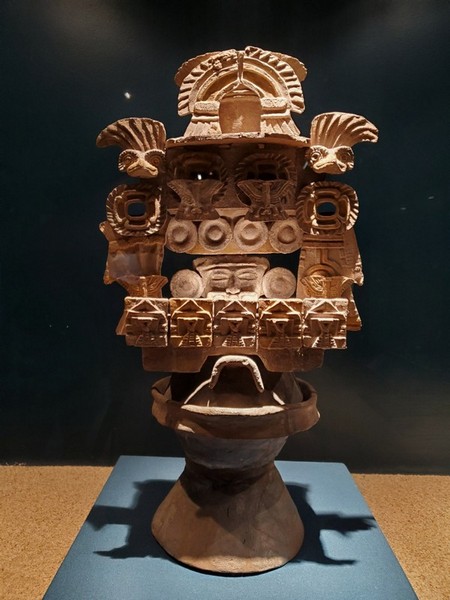
Incense brazier
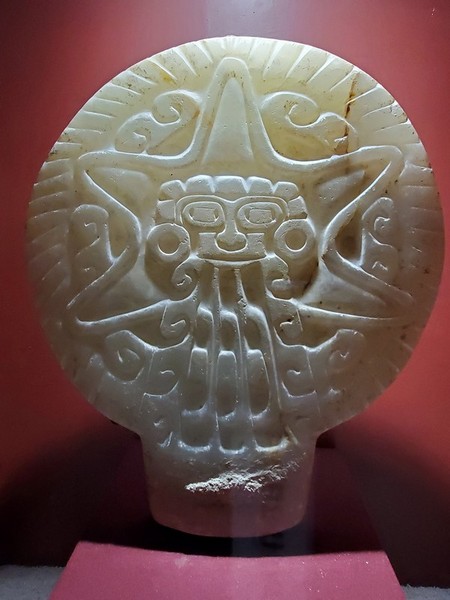
Alabaster carving of Tlaloc, the ancient Aztec god of rain, lightning, floods, droughts, and other natural occurrences.
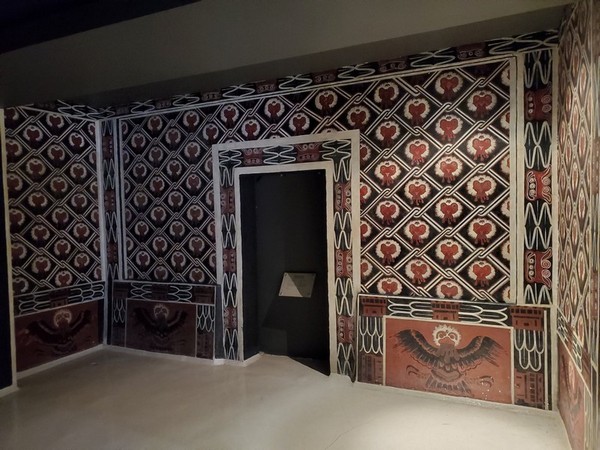
Reproduction of wall murals found in the pyramid complex.
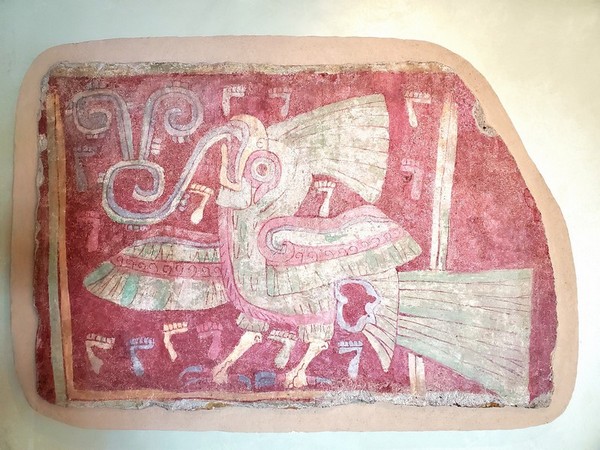
Ancient artists used lime and minerals to create paintings that have lasted for nearly 2000 years. Themes include animals, deities, stars, shells, and scenes of everyday life.

Teotihuacán fresco fragment
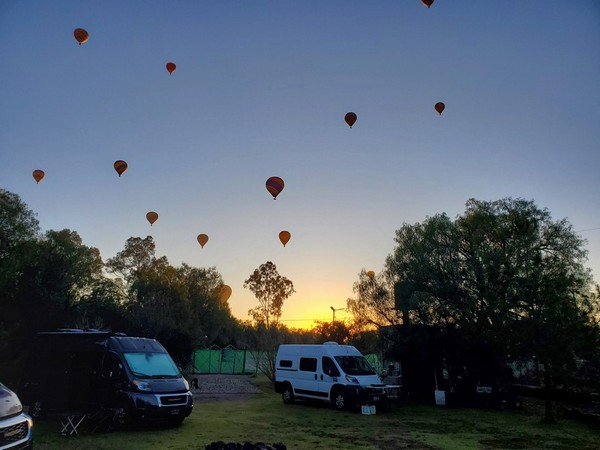
From our nearby campground, we watched balloons drift over Teotihuacán at sunrise.
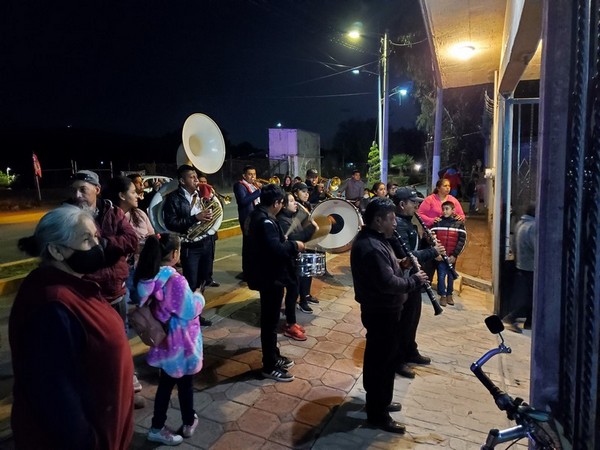
Candelaria (Candlemas) is February 2. In the town of San Juan Teotihuacán, the festivities started nine days ahead. One night a procession went past the campground, with a statue of the Virgin Mary, musicians, and rocket firecrackers that shot up into the air and exploded with a loud boom (these either frighten away the devil, or attract the attention of God). Households invite the procession to stop, and serve food and beverages. The couple at this house told us they ran out of food because there were more people this year.
Women carrying the Virgin Mary statue.
Orizaba, Veracruz
This was our first visit to the city of Orizaba, which has a tropical mountain climate, a beautiful river walk, colonial architecture, an "Iron Palace" designed by Gustav Eiffel, few foreign tourists, and the tallest peak in Mexico.
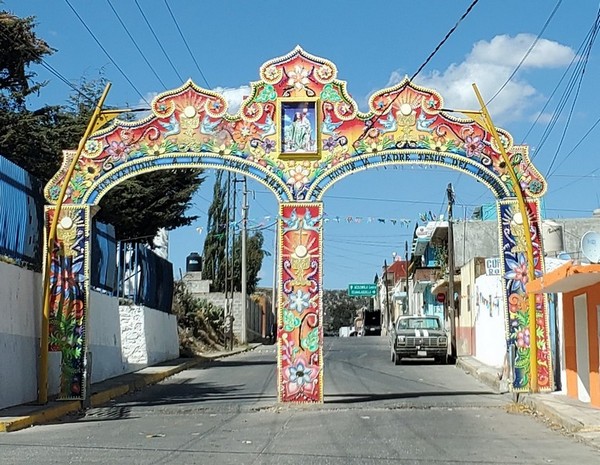
The "libre" (free - no tolls) road to Orizaba took us through a small town with a colorful welcome arch. Some libres are endless potholes and speed bumps, but this one was delightful.
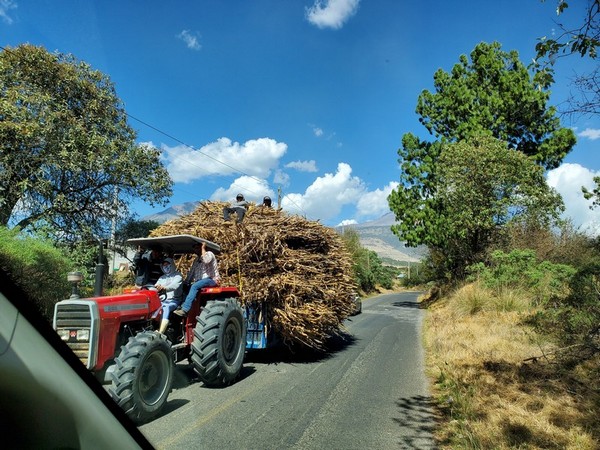
We had to pull onto a grassy shoulder to let this wide load of corn stalks go by. There are guys lounging on top.
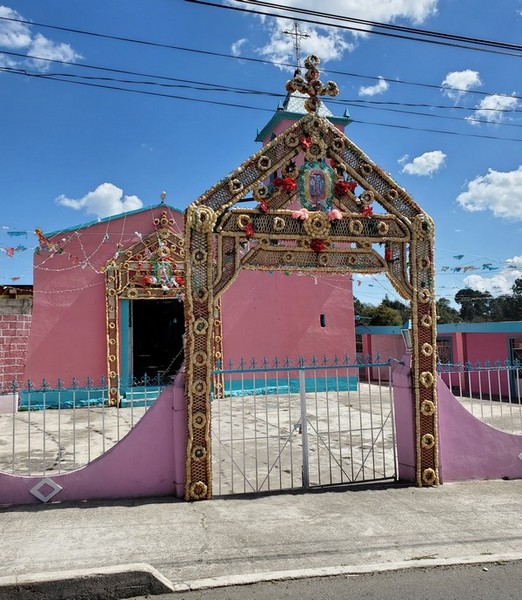
Woven straw arches decorate the entrance to a church in a tiny town in the mountains en route to Orizaba.
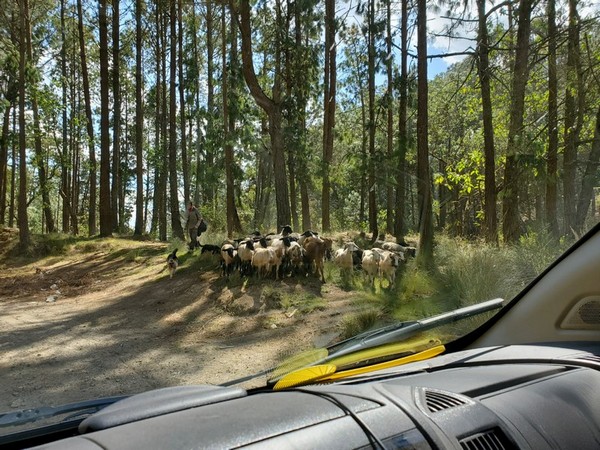
A herder moving his flock through pine trees in the mountains
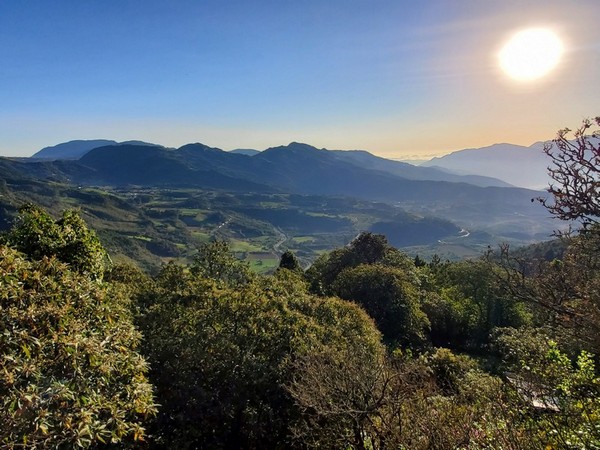
The mountain scenery was spectacular. From this viewpoint at 8200 feet, you can see the serpentine highway descending to 4000-foot Orizaba city far below and just out of sight on the right.

We had great views of the highest mountain in Mexico, Citlaltépetl, or Pico de Orizaba. It is 18,491 feet.
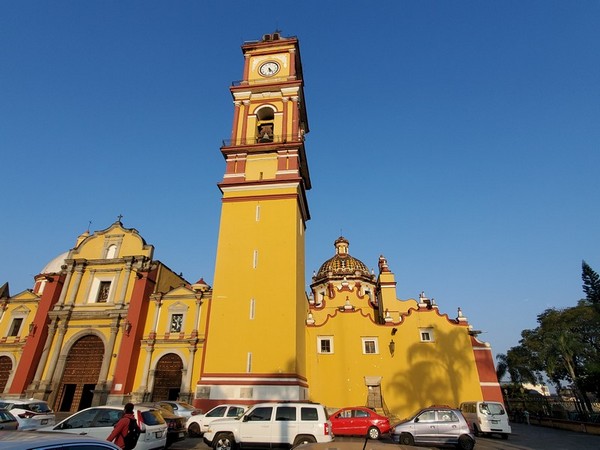
Orizaba's cathedral was built in 1692. I especially liked the colored tiles on the dome.
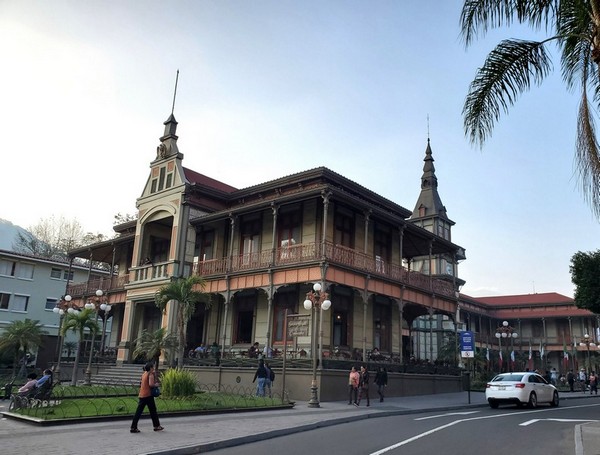
The town of Orizaba commissioned French architect Gustav Eiffel (of Eiffel tower fame) to design and build this art nouveau Iron Palace in the early 1890s and ship it to Mexico. It houses several museums.

Looking down Orizaba's popular pedestrian promenade
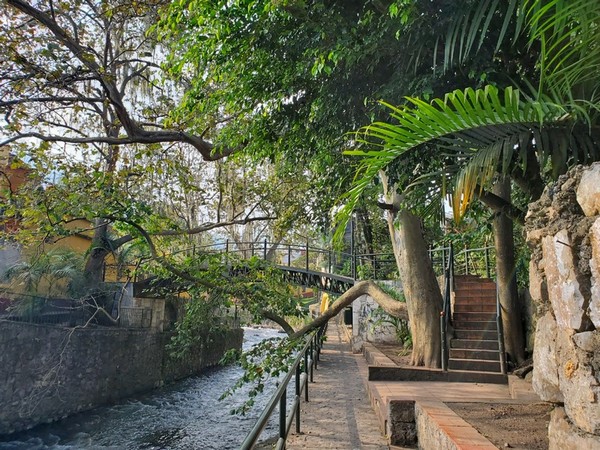
Orizaba's delightful river walk is two miles long. The river and path are sparkling clean.
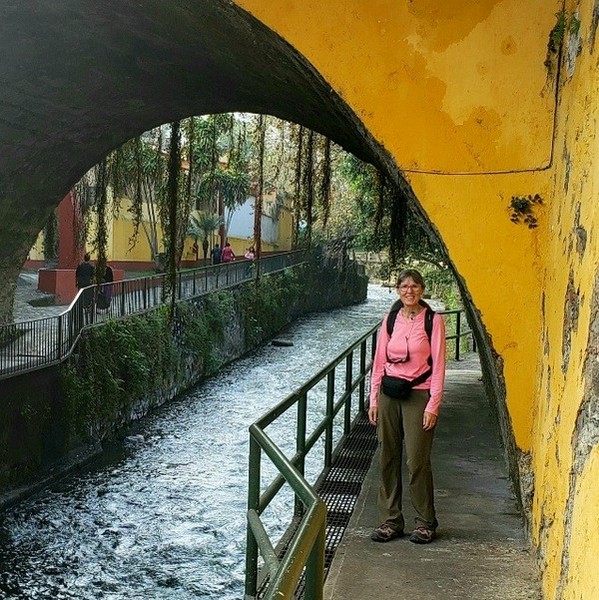
Orizaba river walk
Oaxaca (wah-HA-kuh)
We spent two weeks in the small town of Santa Maria del Tule (aka Tule), 25 minutes from Oaxaca de Juarez (aka Oaxaca city). Both are in the state of Oaxaca.
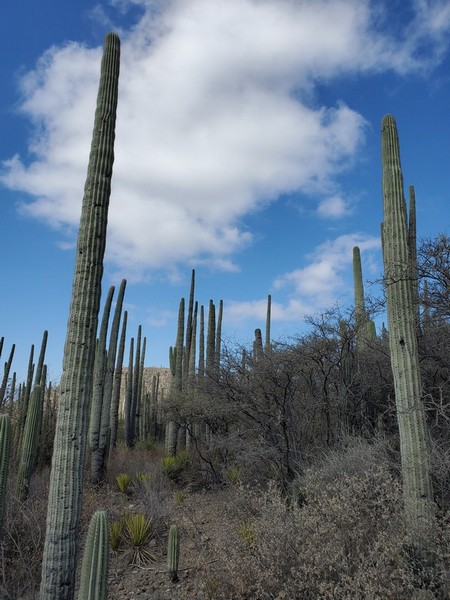
Cactus forest north of Oaxaca. This part of Mexico has one of the highest concentrations of columnar cacti in the world, with forty-five of the seventy species found in the country.
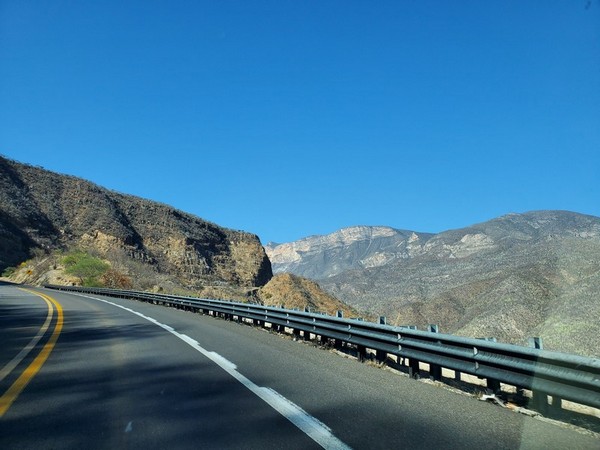
The scenic mountains north of Oaxaca city
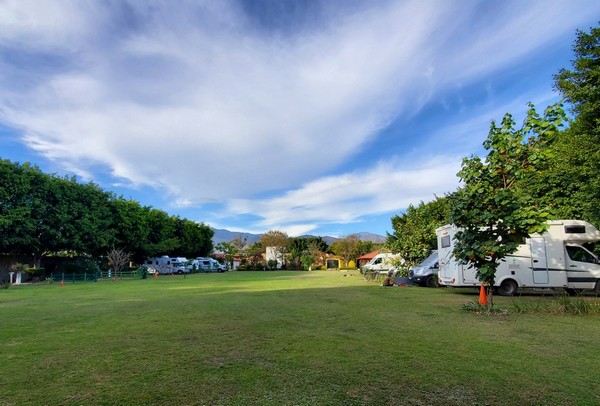
El Rancho campground in Santa Maria del Tule is the nicest one we've seen in Mexico. It has a common area with kitchen, tables, swimming pool, playground, hot showers, and washing machine. It's a short walk into Tule and a 25-minute bus ride to Oaxaca city.
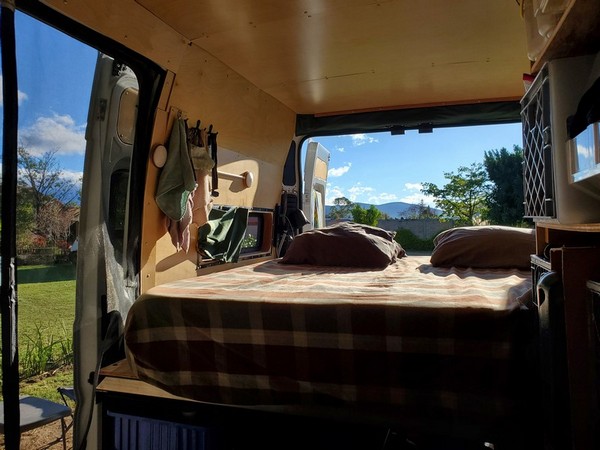
The view from our van. Temps were mid-80s during the day.
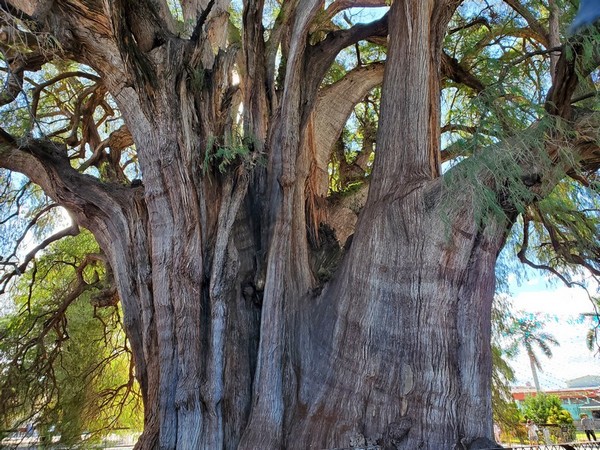
Santa Maria del Tule is famous for a cypress (tule) that is one of the biggest trees in the world (in total volume), and is probably about 1500 years old.
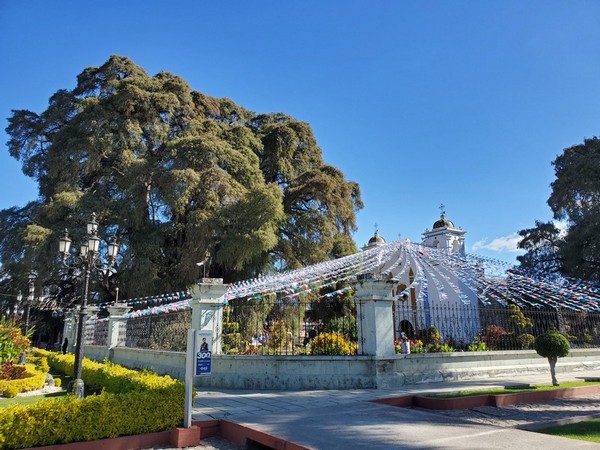
The tule tree dwarfs the town church.
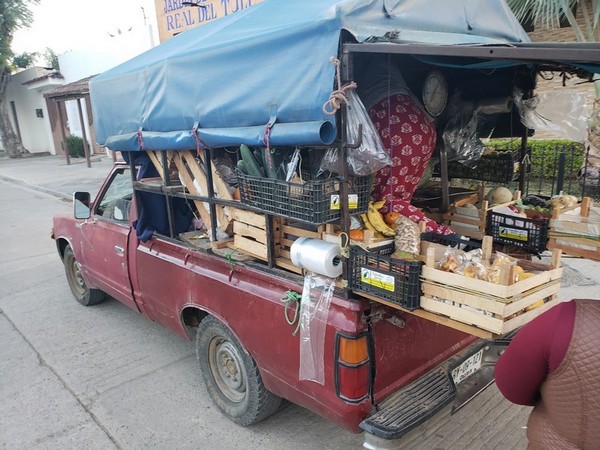
Grocery trucks like this drive around small towns with basics like produce, eggs, and bread.
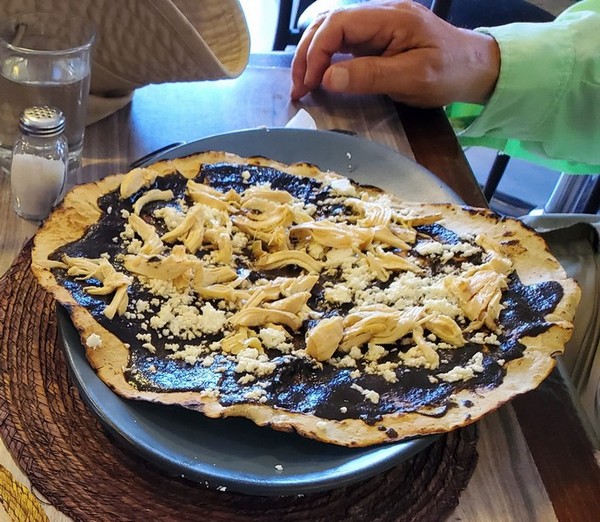
Tlayudas are a popular Oaxacan dish. A thin, crispy, baked corn tortilla spread with your choice of toppings. This one has mole sauce with cheese and chicken. One is enough for two people.
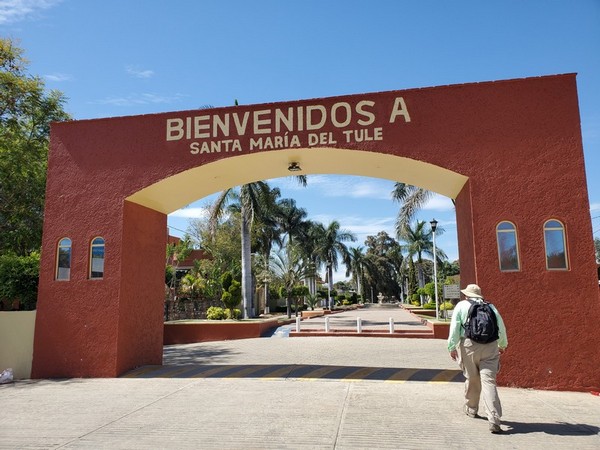
A palm-lined pedestrian promenade runs through the town of Tule.
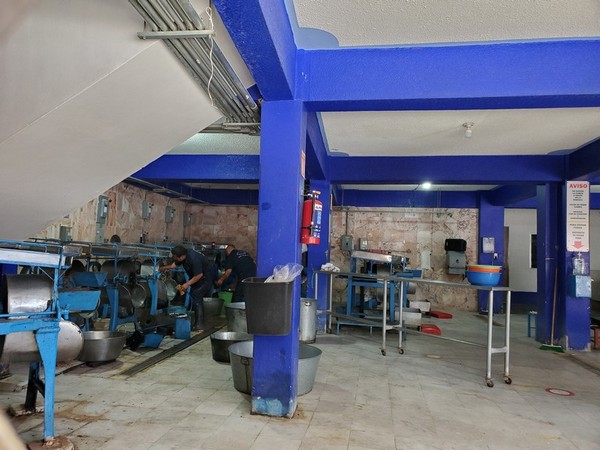
The Tule town mill, where people bring their corn to be ground. Mexicans eat a lot of corn tortillas!
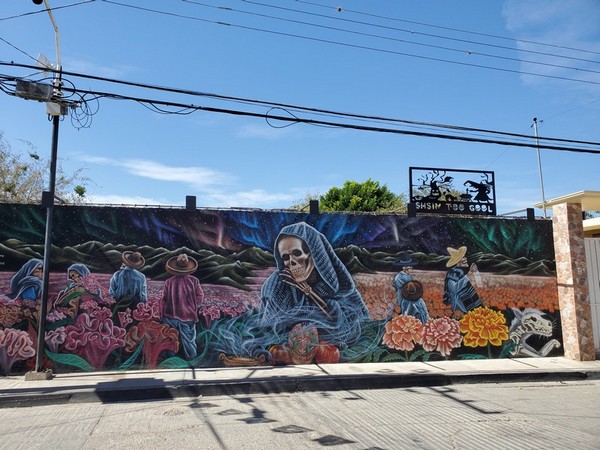
A mural in Tule. In Mexico, death is an accepted part of life.
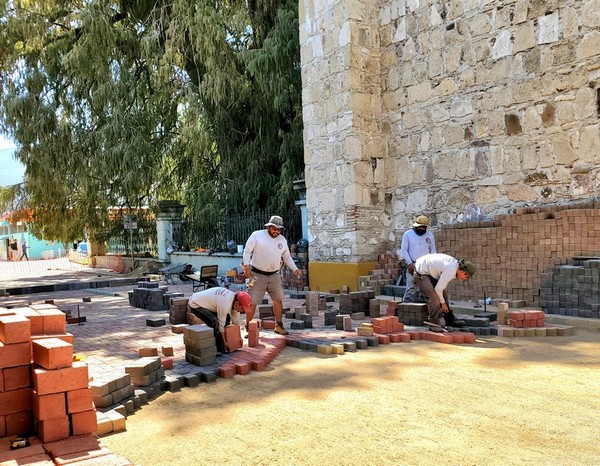
Workers repaving a street in Tule with multi-colored bricks
Candelaria
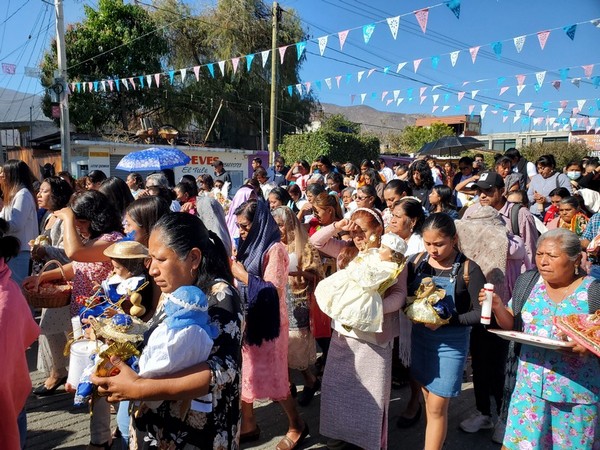
Tule is a great place to be for Candelaria (Candlemas). This religious celebration takes place on February 2, and commemorates that forty days after Jesus was born he was brought to the temple for the first time. People bring their baby Jesus dolls to the church to be blessed. Candelaria is also a blessing of the light (represented by candles) and of seeds (usually corn).
Candelaria procession (click the white arrow in the center of the video)
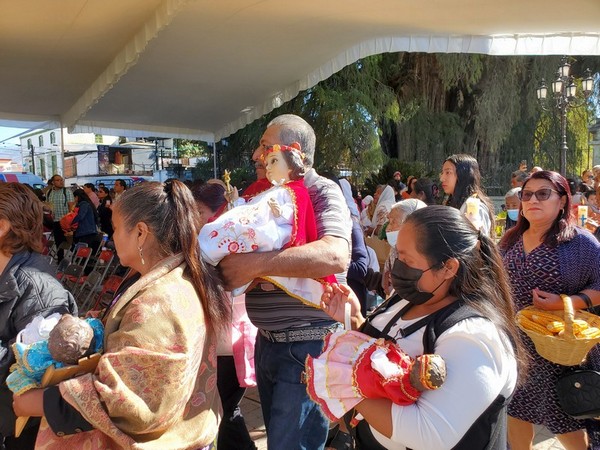
Men have dolls too.
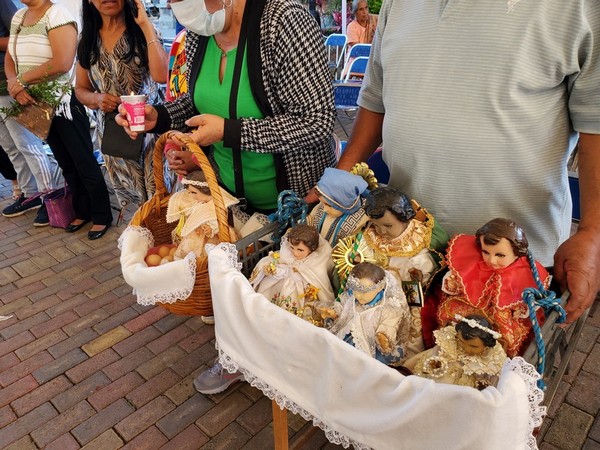
Here you can see a man with six dolls, and a woman carrying a candle and a basket with eggs.
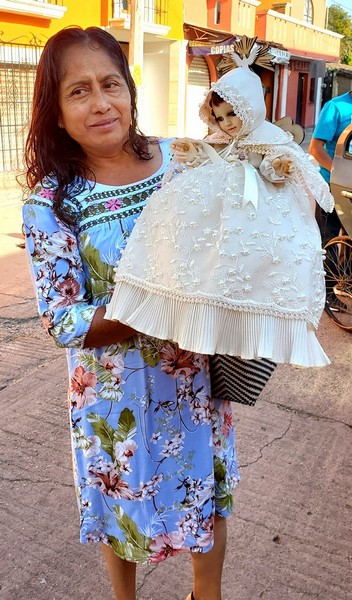
Dolls and outfits can be expensive.
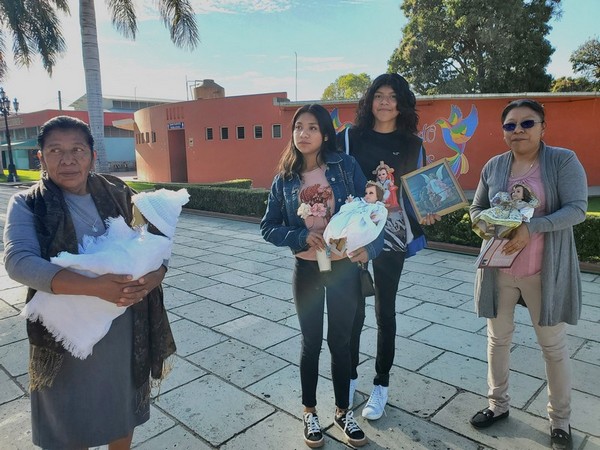
The fragile porcelain dolls are treasured possessions, passed down through generations.
After church, it's time to party! People had a blast at the "regada de dulces" (candy toss).
Small town fun at the Candelaria rodeo. In this 10-second video you will see a novice competitor on a hilariously uncooperative bull.
Oaxaca City
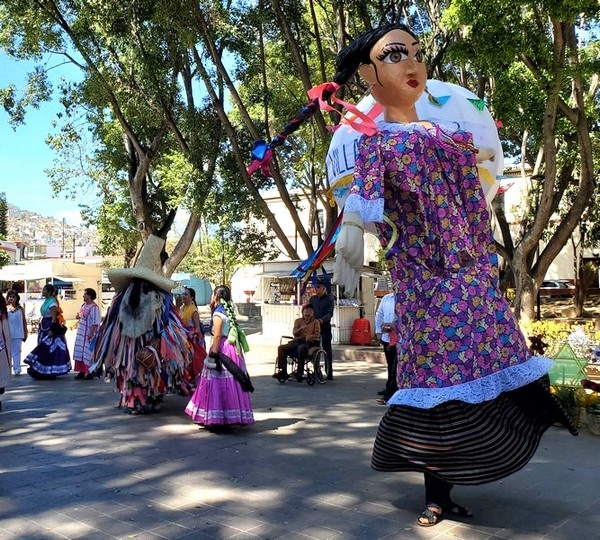
Any excuse for a parade! This one is an 80th birthday party. In Oaxaca, the giant dancing puppets are called monos de calenda.
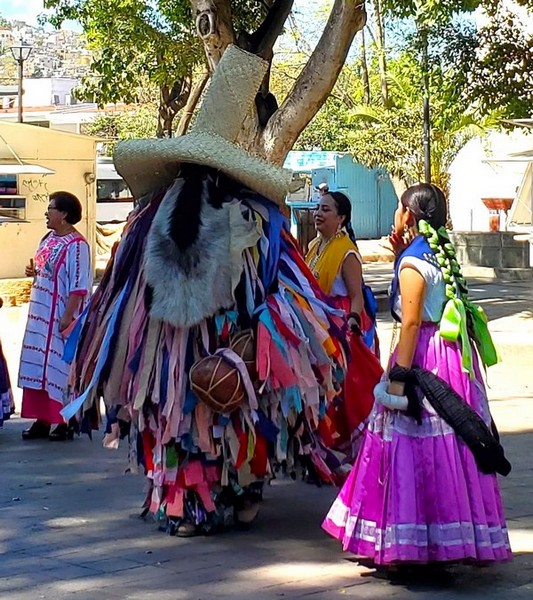
Tiliches (rag wearers) are popular in Oaxacan parades. The mask is traditionally made of animal skin, and the clothes are colorful rag strips that swirl around when the dancer spins.
This video shows the pedestrian street that goes through the heart of town, the beautiful cathedral, and a very talented accordionist.
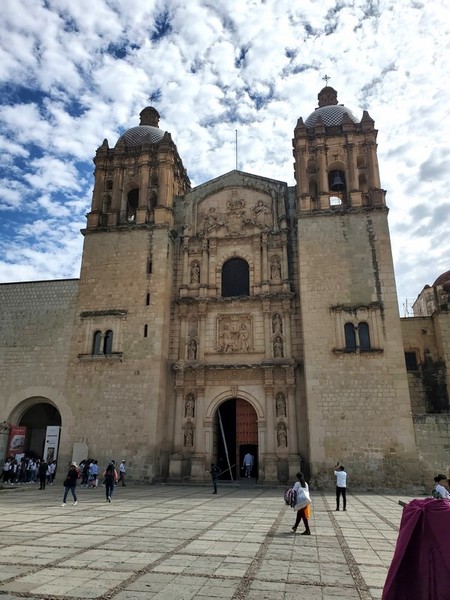
Oaxaca city cathedral
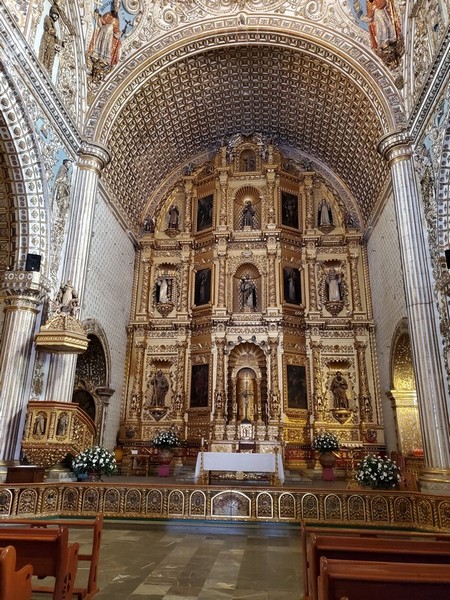
The stunning interior of the cathedral
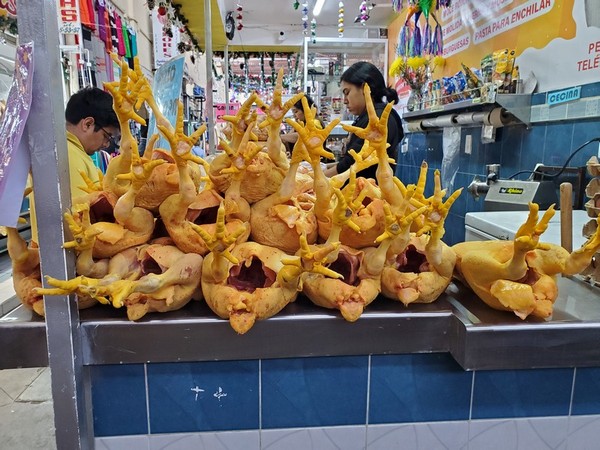
Oaxaca has amazing markets. These chickens may not agree.
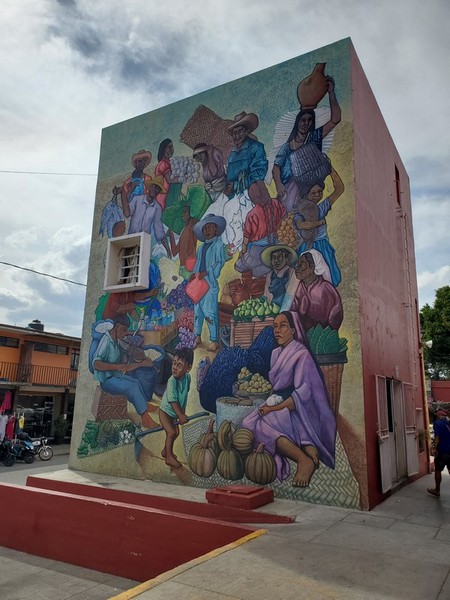
Oaxaca mural
Tlacolula Sunday Market
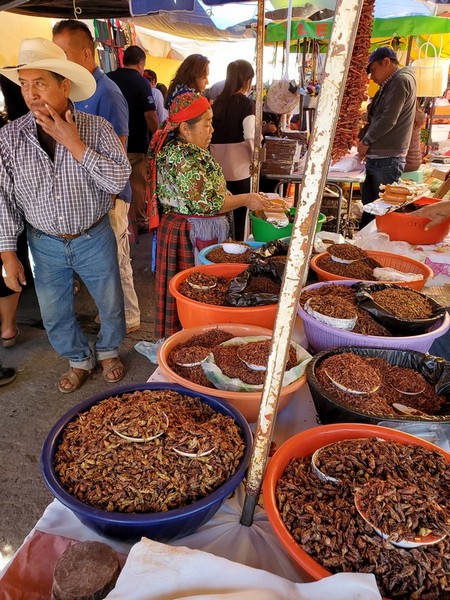
The Sunday market in the town of Tlacolula is a feast for the senses, and a chance to be surrounded by indigenous culture. Here a woman buys dried grasshoppers with chili seasoning.
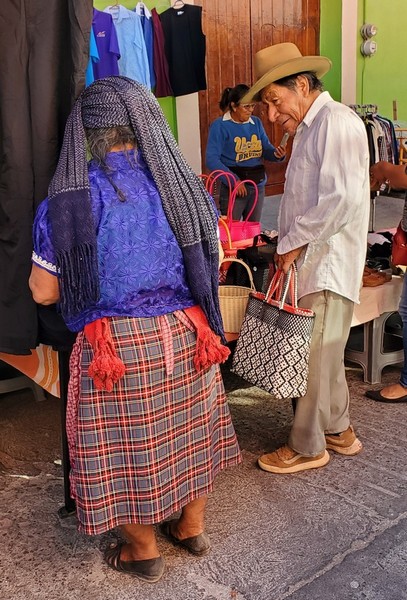
An older couple doing their shopping
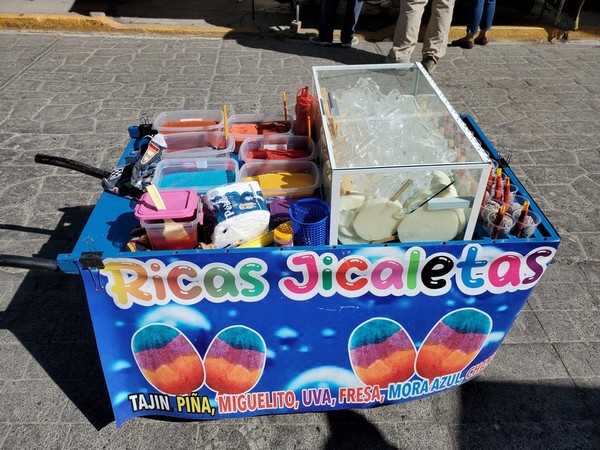
Jicaletas (jicama popsicles) are a round piece of ice cold jicama sprinkled with flavored sugar.

This stall sells sausage, bacon, and huge slabs of chicharrón (deep fried pork skin).

These stalls sell barbacoa (meat that is slow-roasted, often in a pit). It's usually eaten as tacos or soup.

Grant had goat consomme, and said it was the best soup he'd ever eaten. We declined the shots of mezcal our table mates assured us would be good for digestion!
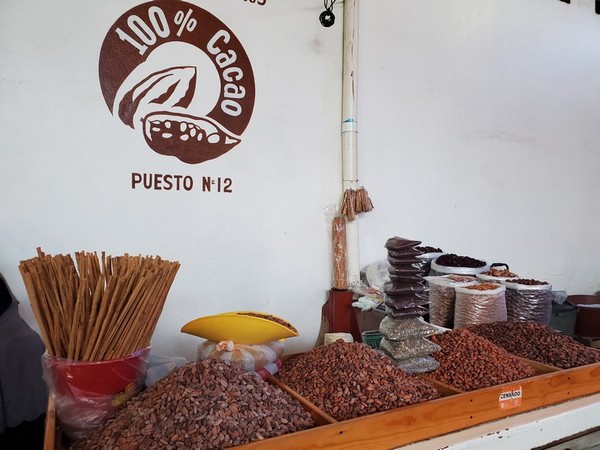
The roots of chocolate go deep in Oaxaca, where indigenous people have used it for centuries in all kinds of foods and beverages. My favorite is a bowl of hot, frothy chocolate with milk and cinnamon.
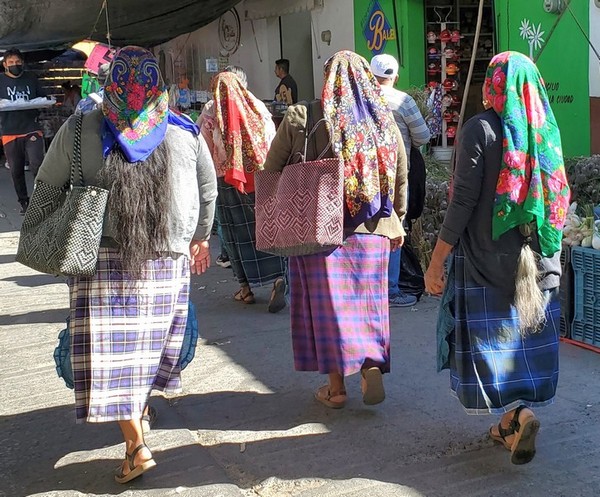
I loved seeing the Zapotec women in their colorful clothes, and hearing their soft language.
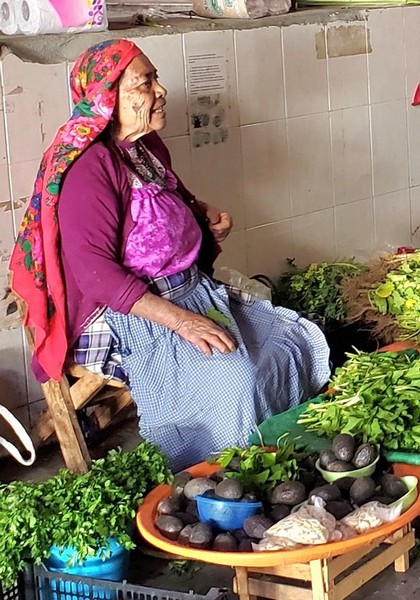
Zapotec woman selling cilantro, greens, and avocados
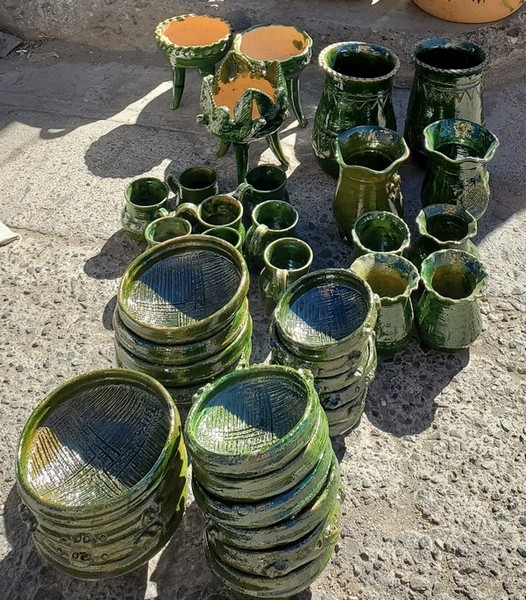
Green pottery from the nearby town of Atzompa
Atlixco, Puebla
This was our first visit to Atlixco, a small town known for flowers, colonial architecture, and proximity to Popocatépetl volcano.
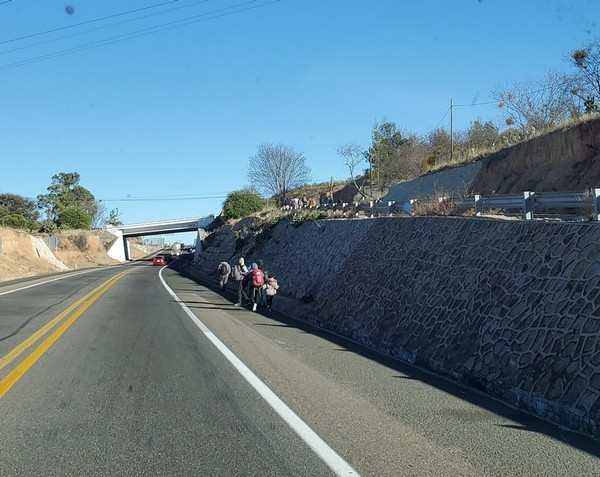
As we drove north from Oaxaca we saw hundreds of migrants walking along the road, including women carrying babies (here you can see several next to the highway and others up above). These are mostly people from Central America fleeing poverty, violence, and the impacts of climate change. It was heartbreaking. There are no easy answers. Mexico is generous in offering humanitarian visas which allow people to legally live and work there. If you want to help, you can donate to organizations that provide food, shelter, jobs, and legal assistance. Here is one good one: https://latinamericanrelieffund.org/
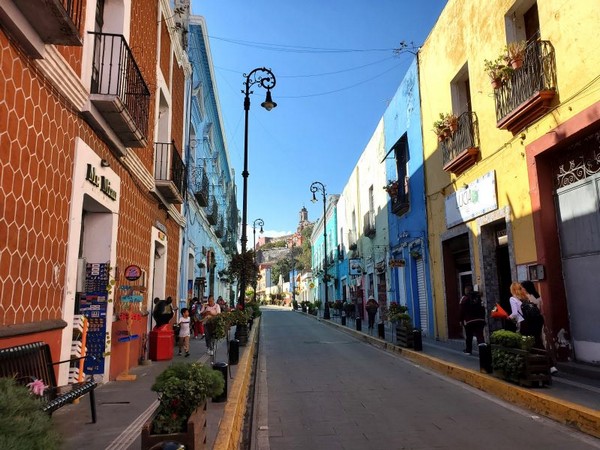
Atlixco de las Flores is one of Mexico's 177 Pueblos Mágicos, towns that are recognized for characteristics and traditions that make them unique and historically significant. It's a beautiful small town with flower-lined streets, in the mountains near Mexico City.
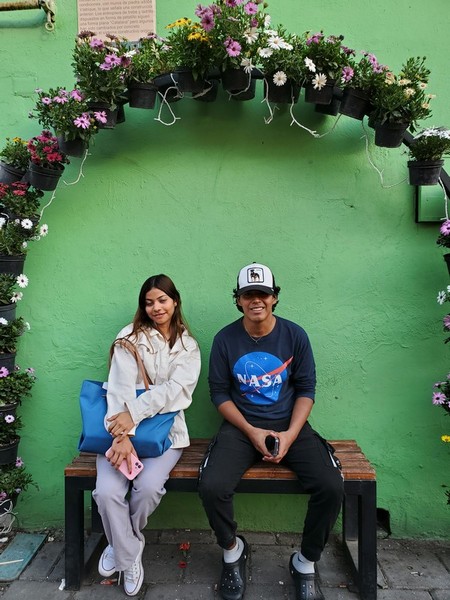
Renata and Fran are students at the university in Atlixco. They heard us speaking English and wanted to practice. These flower arbor benches are all over the town.
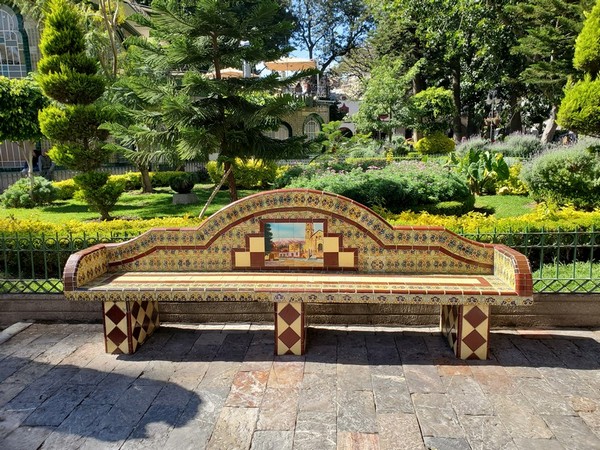
Tiled bench in the square
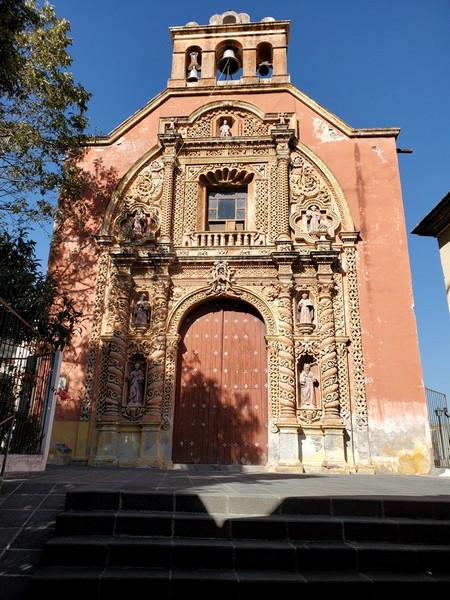
Intricately-carved stonework on a colonial-era church in Atlixco
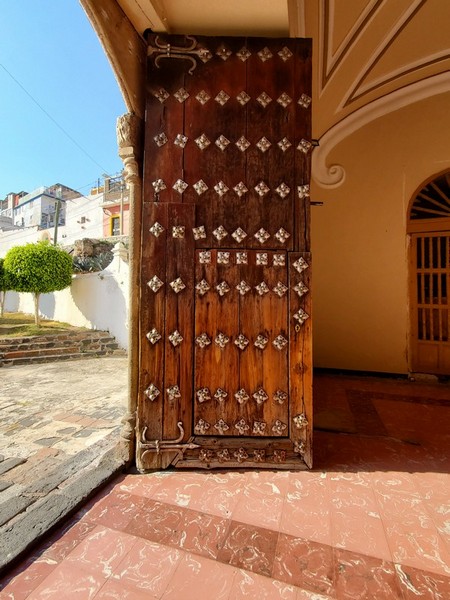
Old studded church door
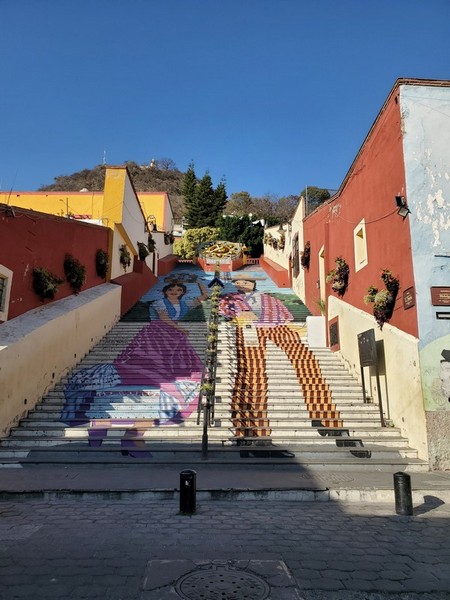
A painted stairway called La Escalera Ancha leads up to the mirador (viewpoint) above town.
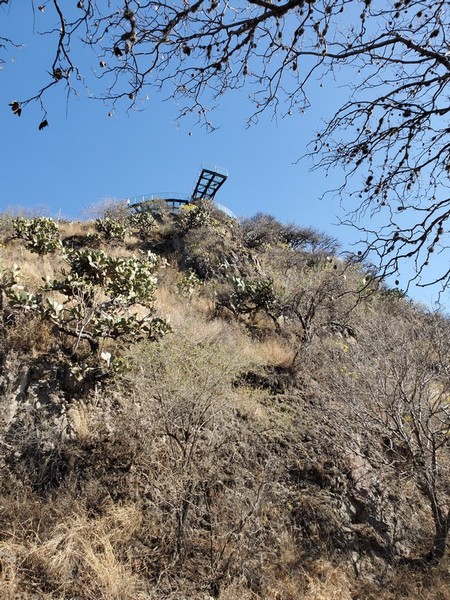
As I walked up the hill to the mirador, I could see the recently-completed glass viewing platform above me.
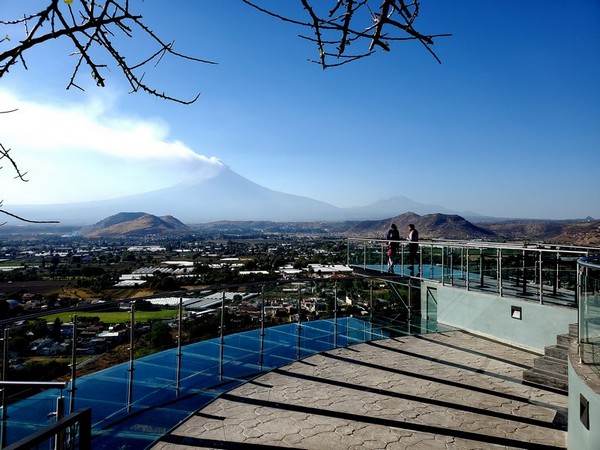
From the mirador there is a magnificent view of 17,694-foot Popocatépetl, about 35 miles away. Although the volcano started erupting in 2016, the intensity has increased over the past year. We were lucky to see it on a clear day when the wind was blowing the smoke away from the town.
Pátzcuaro, Michoacán
Pátzcuaro is one of our favorite places in Mexico. It's at 7000 feet in pine and oak forest, with cool nights and warm days. It has relatively few gringos, and a thriving indigenous culture.
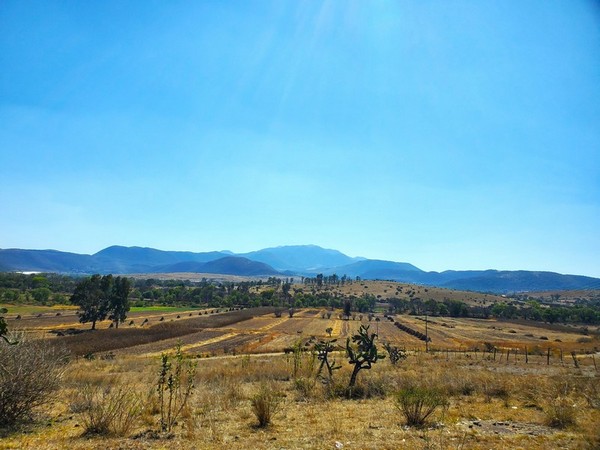
Michoacán is a beautiful state, with lots of farmland. You can see cone-shaped stacks of cornstalks drying in the fields.
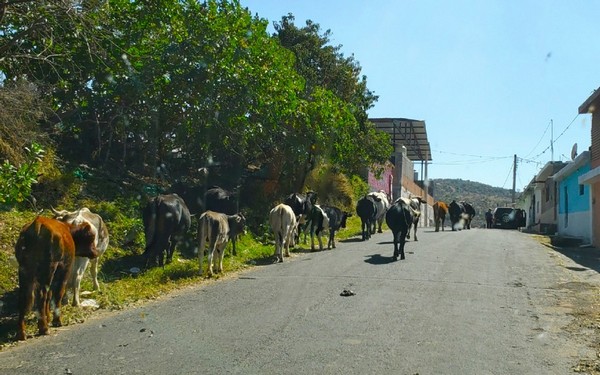
Sharing a free (non-toll) road in rural Mexico
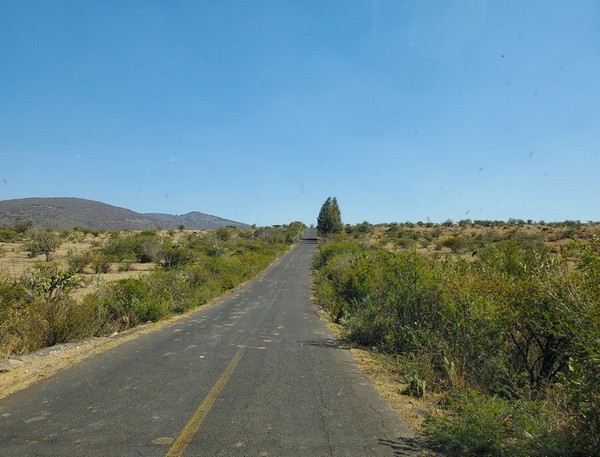
A typical free road out in the country is scenic, but narrow, with no shoulders, and often has a lot of potholes.
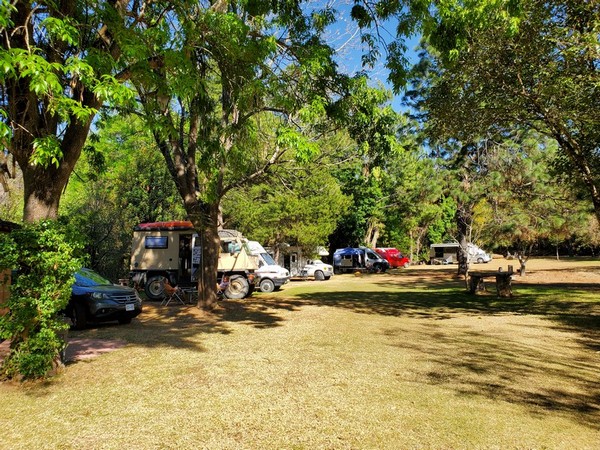
Our campground in Pátzcuaro is on a large family property with many trees. It's an oasis of green and quiet just outside the busy town center.
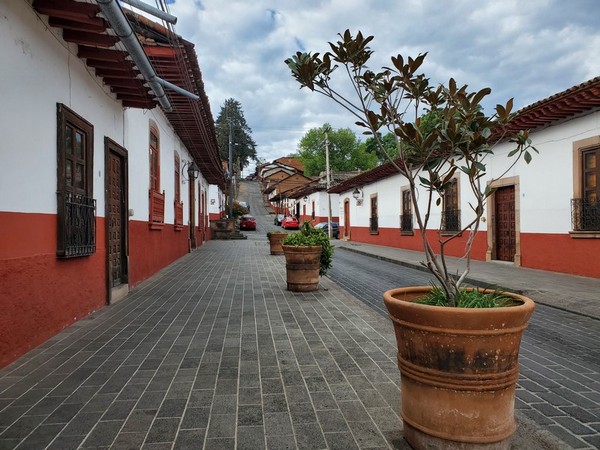
The buildings in Pátzcuaro are painted white and red.
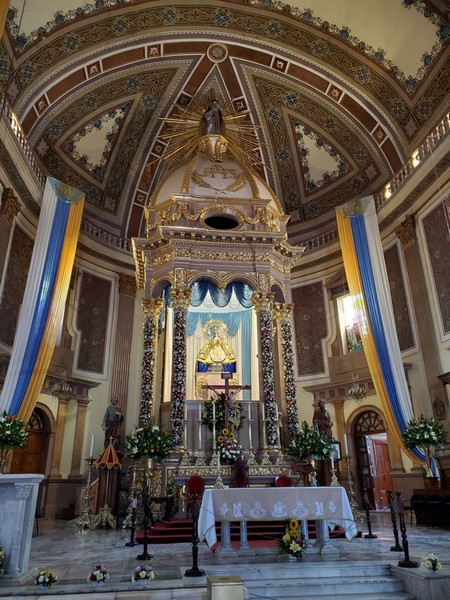
Inside the Basílica de Nuestra Señora de la Salud (Our Lady of Health) is an almost-human-size image of the Virgin of Health, made in the 1500s by local people out of corn stalk paste (and later dressed in elaborate robes). Soon after she was made, miraculous cures began to happen. Each December 8, pilgrims come from far and wide to pray for cures.
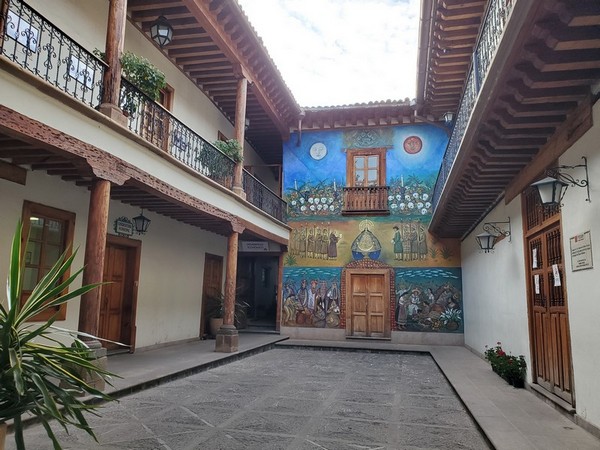
Government building courtyard and mural
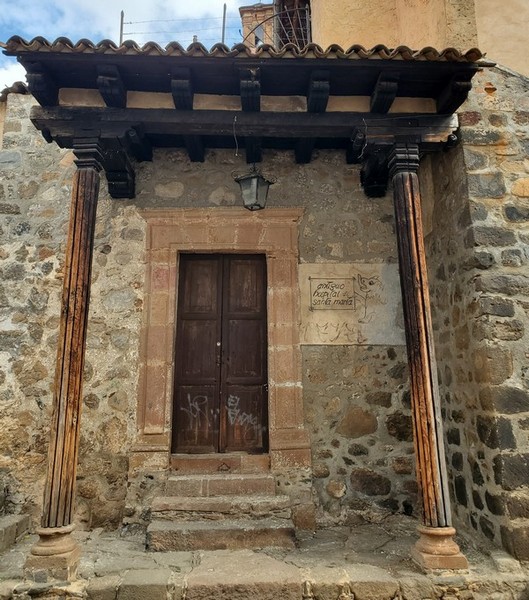
This building from the early 1500s once housed a hospital.
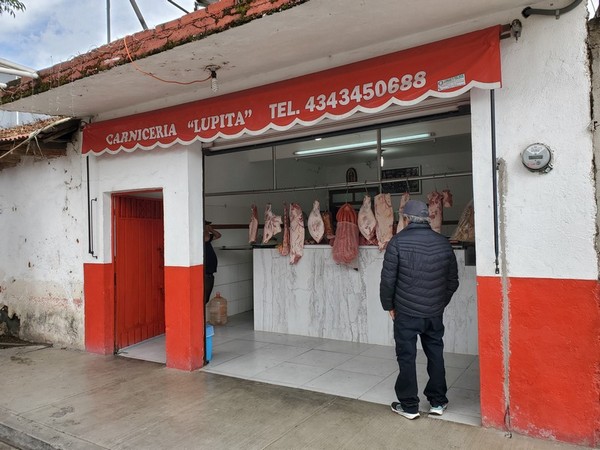
Meat shop near the campground
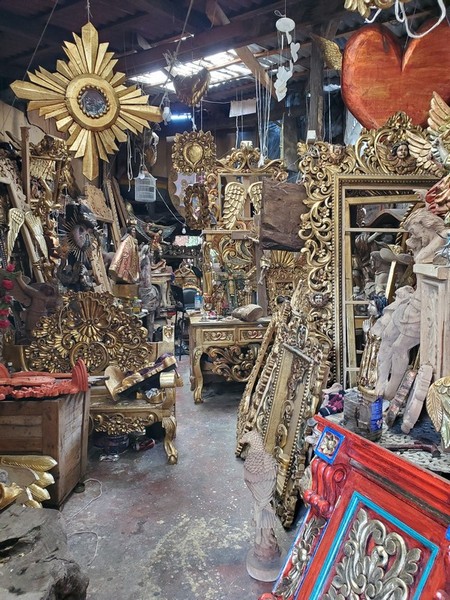
Woodworking shops line one of the streets
I had the great pleasure of hearing this Bolero trio, featuring a truly phenomenal guitar virtuoso. Bolero music originated in Cuba. Its use in black and white romantic films during the golden age of Mexican cinema in the mid-1900s forever endeared it to Mexican hearts. These are songs of romance.
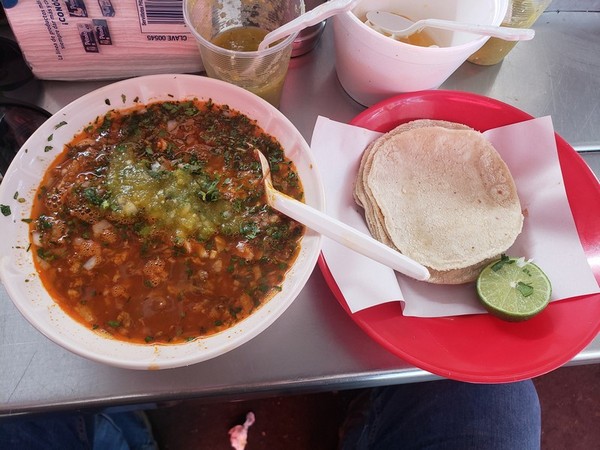
Grant fell in love with "sopa de rez," beef soup with a rich, flavorful broth, to which you add onion, cilantro, lime, salsa, and tortillas.
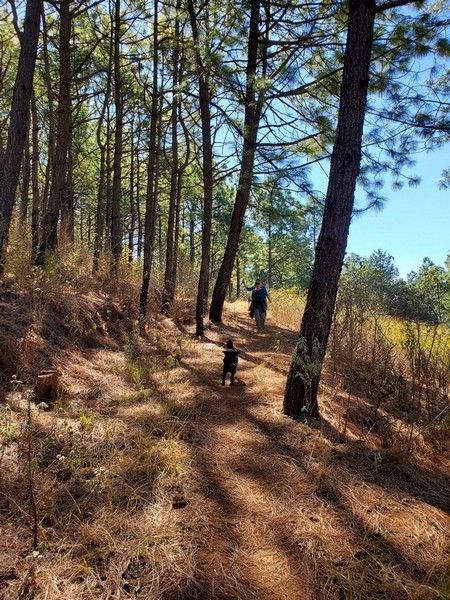
I hiked to the top of Cerro Blanco (White Peak) with friends Susan and Meg, through a pine forest.
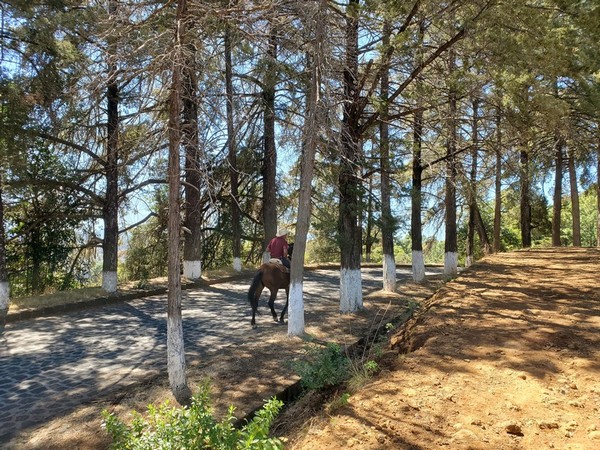
It's a lovely walk up to the mirador (viewpoint) for views of the lake and surrounding mountains.
Janitzio Island
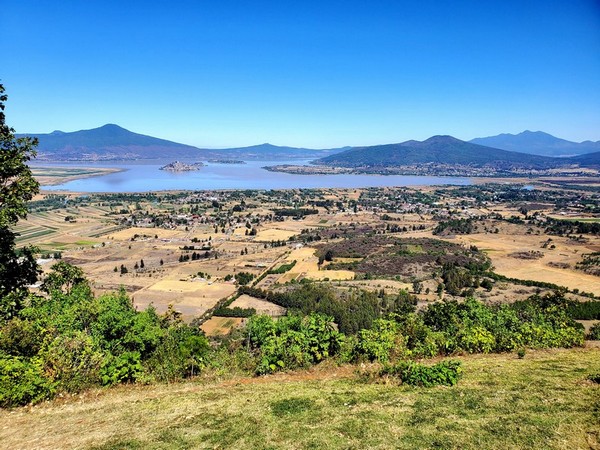
Pátzcuaro Lake has several islands that are home to indigenous Purépecha people. The lake is facing many challenges (logging, agriculture, siltation, water diversion, untreated sewage, exotic species, chemical pollution). 79% of the people in this area live in poverty or extreme poverty, and many are dependent on the lake for food and transportation.
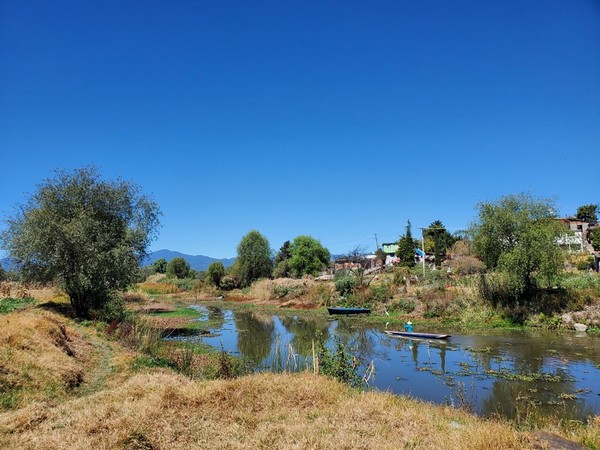
Uranden Island in Lake Pátzcuaro
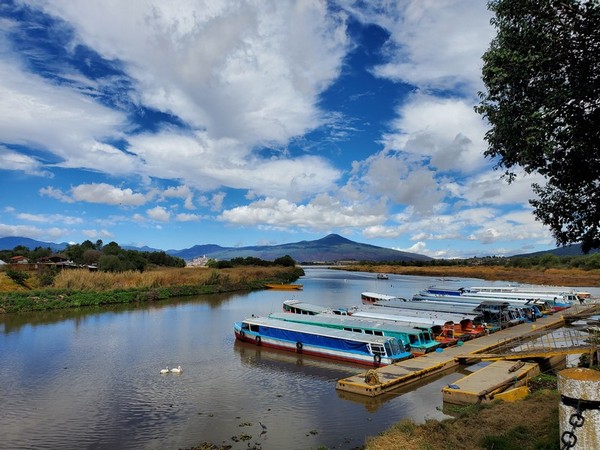
Passenger boats go back and forth to islands in the lake.
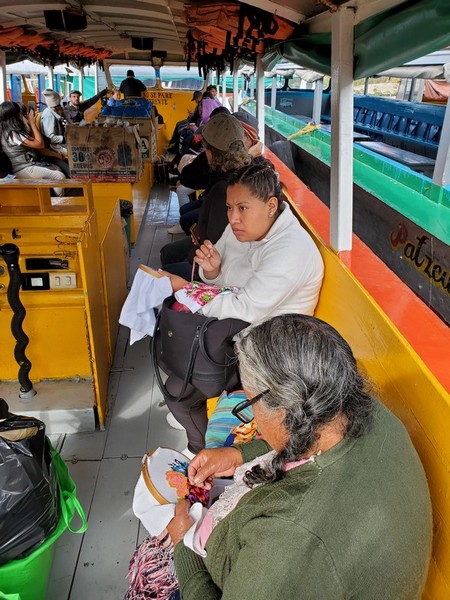
Women embroidering blouses on the boat to the island
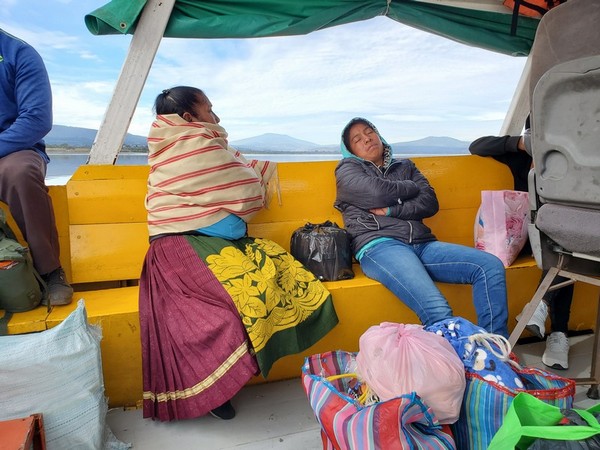
Women on the boat wearing traditional and modern dress
Fishermen demonstrating their butterfly fishing nets.
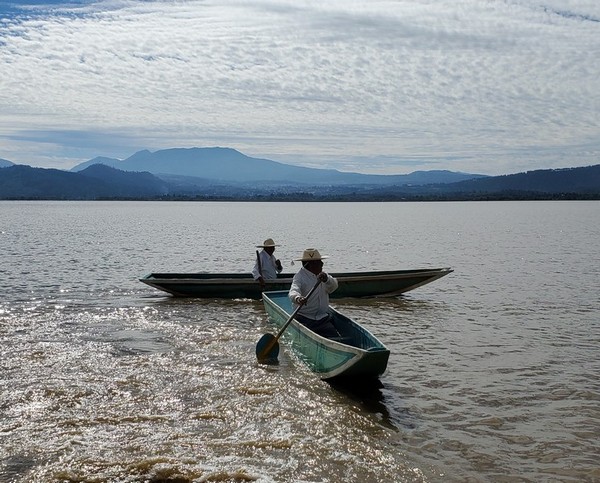
Traditional wooden fishing boats
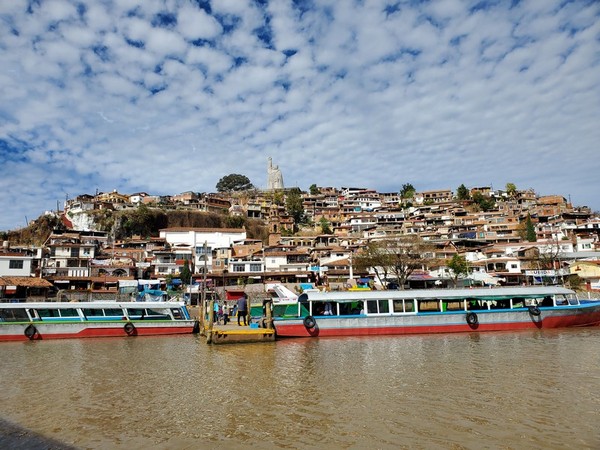
Janitzio is a small, indigenous Purépecha island.

The morning I went to the island, I saw a crowd gathered at the arena and wondered what was happening.
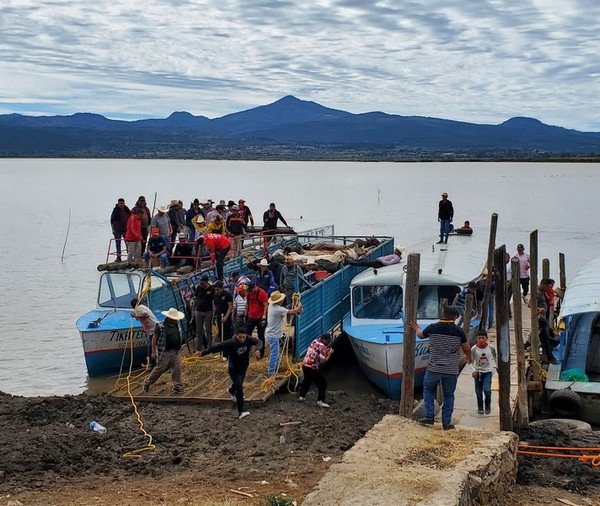
A barge had arrived with 10 bulls for a Carnival rodeo.
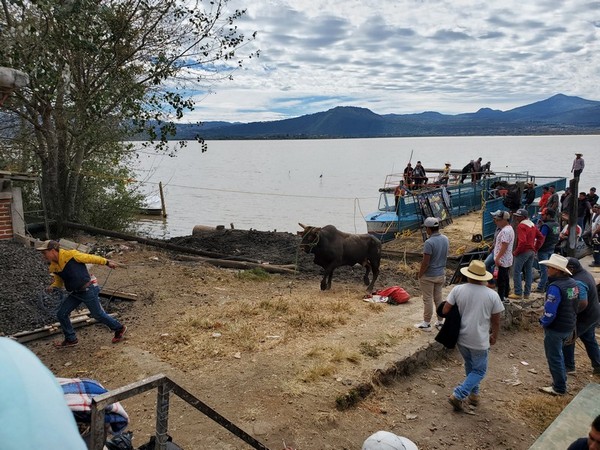
Unloading the bulls
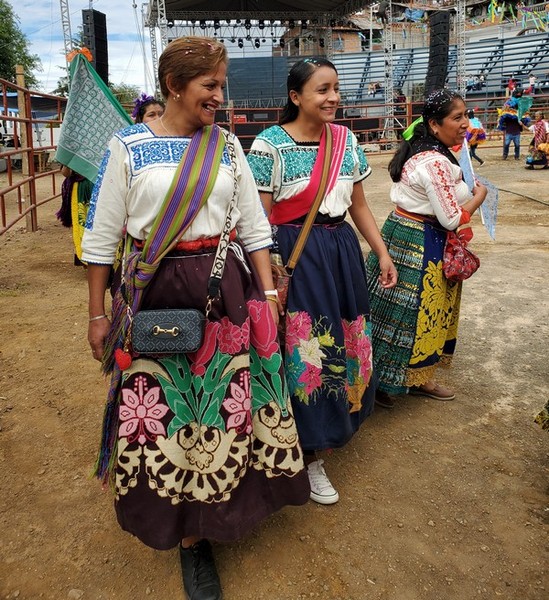
To celebrate the bulls' arrival, the village women danced. I was thrilled to happen upon this local, non-tourist event.
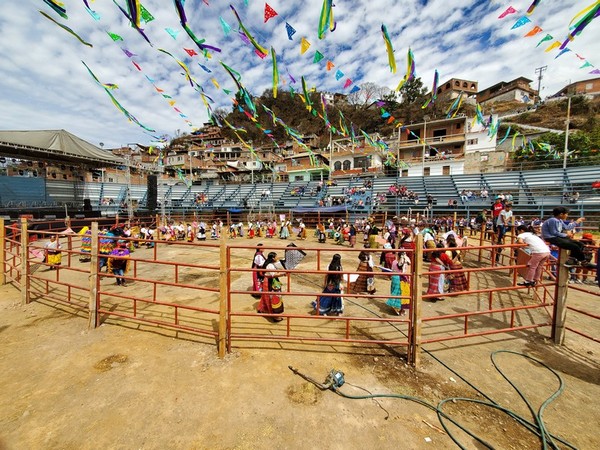
Women dancing in the arena
Women dancing in the arena.
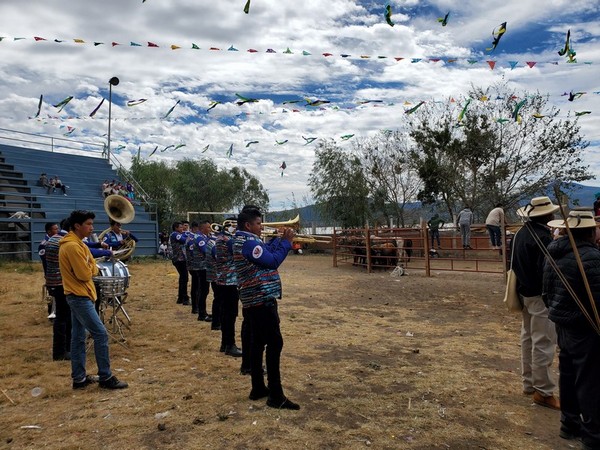
The musicians wore snazzy clothes too.
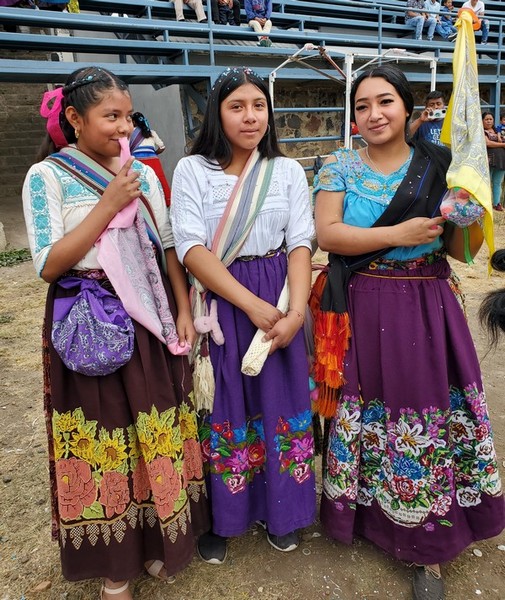
Girls with confetti in their hair, wearing traditional pleated skirts, flowered aprons, embroidered blouses, and woven shawls
After the bulls were safely unloaded, the women invited the men to dance. The song was Ghost Riders in the Sky!

Back in Pátzcuaro, I saw a Purépecha ceremony in the main square. As best I could understand, it was an annual cultural celebration. Their culture was nearly wiped out in the 1500s. The women are holding baskets of bread.
Traditional Purépecha dance. The women have baskets of bread on their heads.
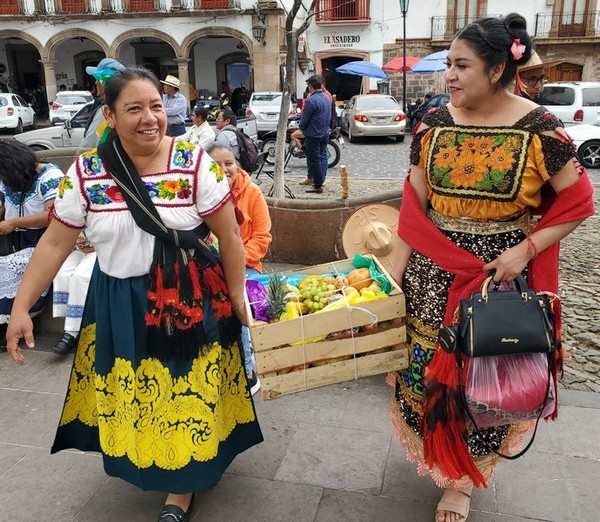
Women carrying "fruits of the land" to distribute to the crowd during the ceremony.
Carnival
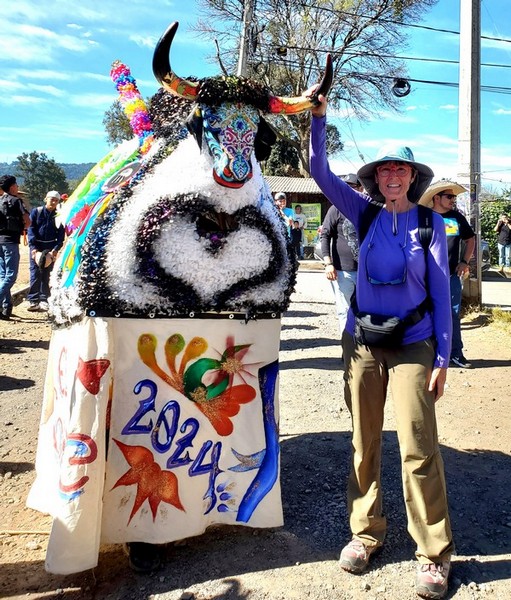
Carnival is the revelry before Lent. In Pátzcuaro, each neighborhood creates a "torito" (little bull) and dances it through the streets for three days. On Tuesday evening (what we call Mardi Gras) they all join together for a big parade. The toritos are works of art. This one has a carved wooden head decorated with beads, painted horns, and a body made of cardboard covered in strips of curly paper. A person stands inside the bull.
Spectators like me are pulled in to dance as the parade moves down the street.
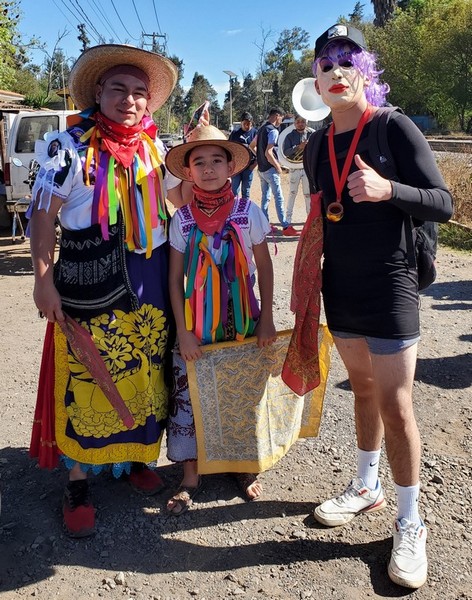
Characters in the dance include "maringuias," men dressed as women who "taunt" the bull by waving flags.
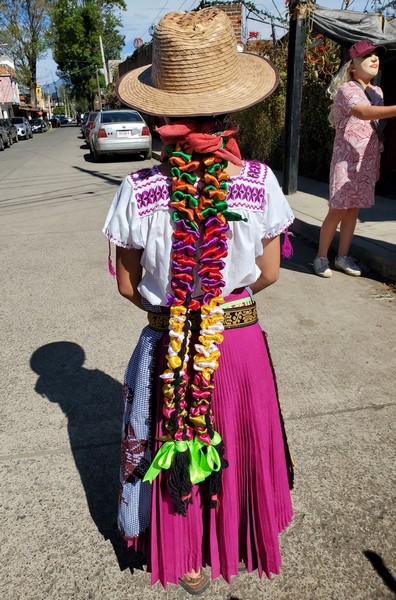
Some maringuias wear traditional Purépecha clothing like this, and some wear modern attire.

Modern and traditional maringuias. Guys have a lot of fun with their costumes. Uglier seems to be better for the modern maringuias!
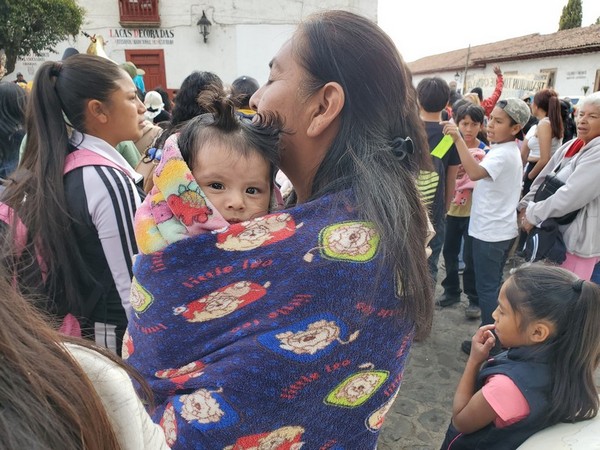
A pint-sized parade watcher
At the Carnival grand finale, eight neighborhoods paraded their torito (little bull) through the streets, with music, costumes, and team spirit. My understanding is that the toritos dance began in colonial times and represents bullfighting, while also poking fun at the Spanish colonizers.
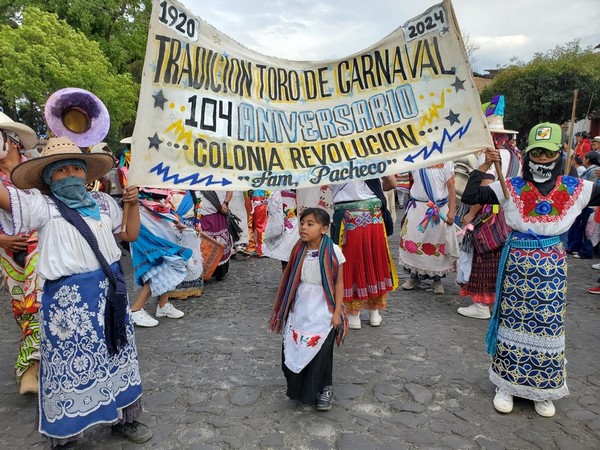
The parade promotes neighborhood pride.
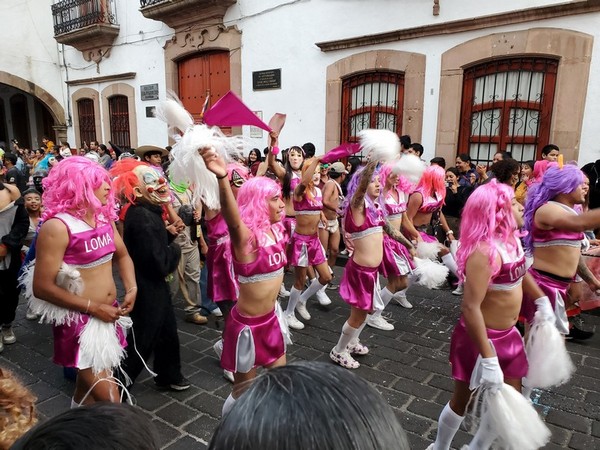
The crowd loved this neighborhood's maringuia cheerleaders.
Westward
After two wonderful weeks in Pátzcuaro we headed west, stopping to visit the towns of Paracho, Ajijic, and Tequila, before spending a few days on the coast near Mazatlan, and driving back to the States.
Paracho, Michoacán
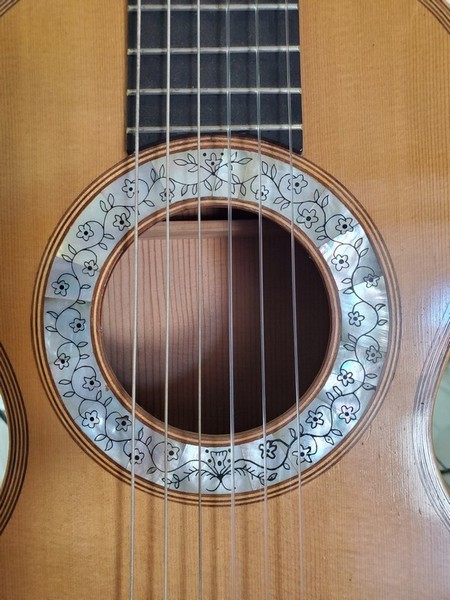
The town of Paracho is famous for makers of high-quality nylon-string guitars and other stringed instruments. I've read that most guitars played in Mexico are made here. Every one I saw had a unique rosette design.
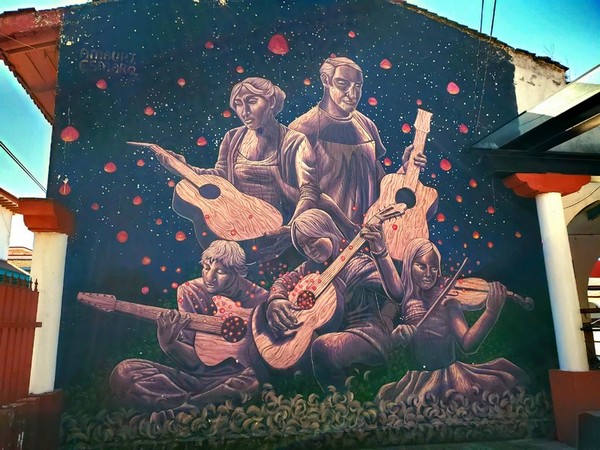
A mural in Paracho shows some of the types of stringed instruments.
Ajijic, Jalisco
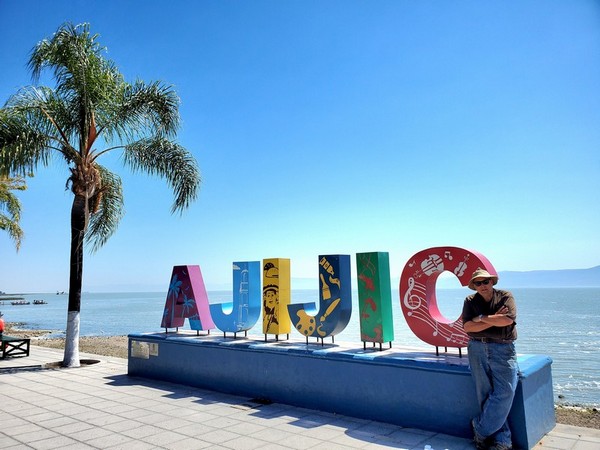
Ajijic is a small town on the shore of Lake Chapala that's very popular with elder gringos. We met up with some friends here for two nights.
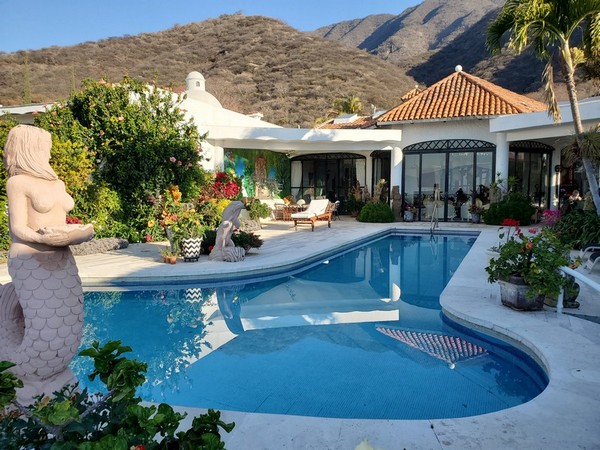
I went walking in the hills above Ajijic and met a lovely British woman who invited me to see her garden and view of the lake. You never know what you might find behind a wall!
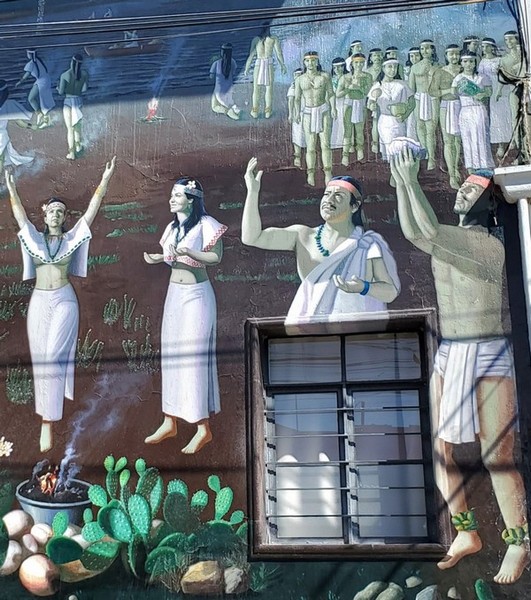
One of many beautiful murals in Ajijic. This one shows the history and culture of the indigenous Mayo people.
Tequila, Jalisco
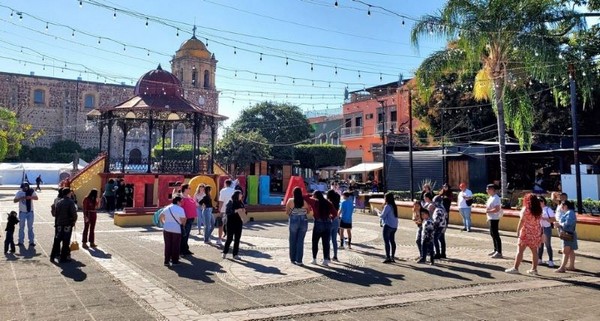
Yep, Tequila is the birthplace of tequila (made from blue agave). The town was swarming with Mexican tourists on a Sunday. Many come here from nearby Guadalajara to tour distilleries, sample tequila, and shop for tequila souvenirs.
The Danza de los Voladores (Dance of the Flyers) is an ancient Mesoamerican ceremony. It is still performed as a religious ritual in a few places, but mainly it is now performed for tourists. The ceremony has been designated by UNESCO as "intangible cultural heritage." The pole is 90 feet tall. The slow descent of the flyers is mesmerizing to watch.
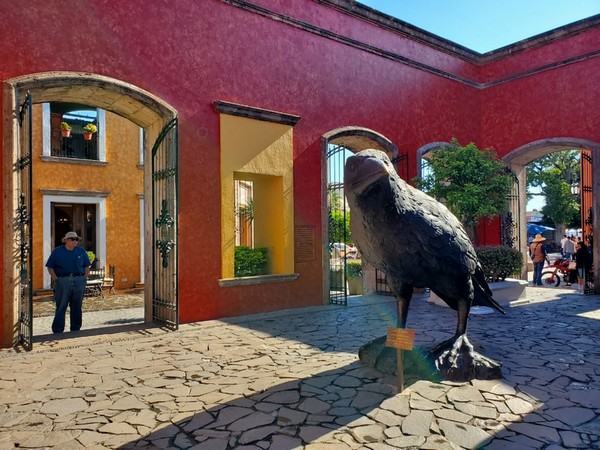
Jose Cuervo (Joe Crow) is the oldest working tequila distillery.
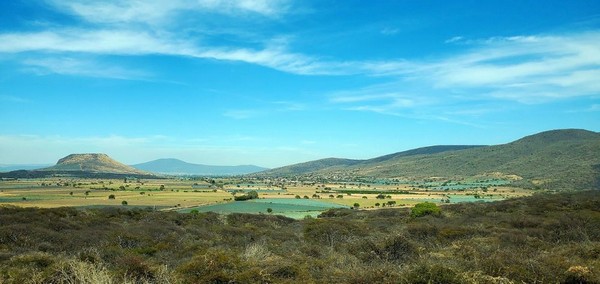
Fields of blue agave in Jalisco
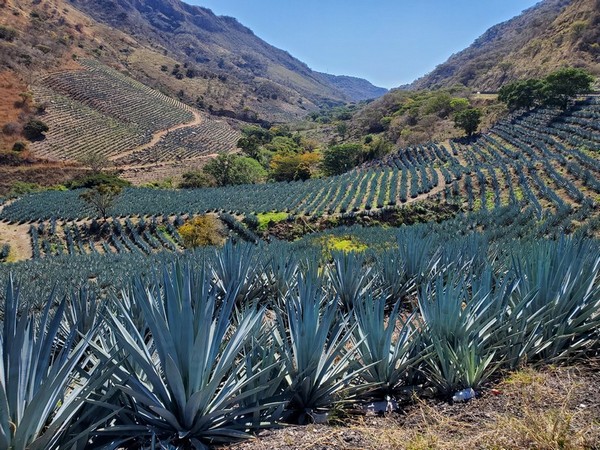
The agave cores are roasted, juiced, fermented, and distilled to make tequila.
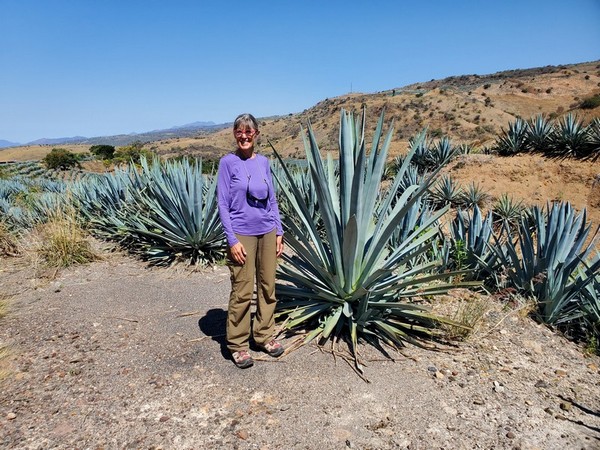
Blue agave
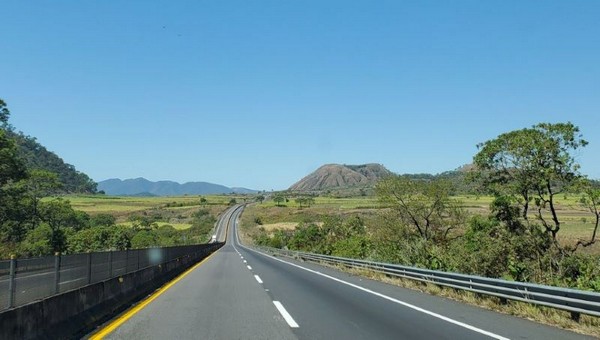
On the drive to Mazatlan, we dropped from pine-oak forest at 5000 feet to sugarcane fields on the coast.
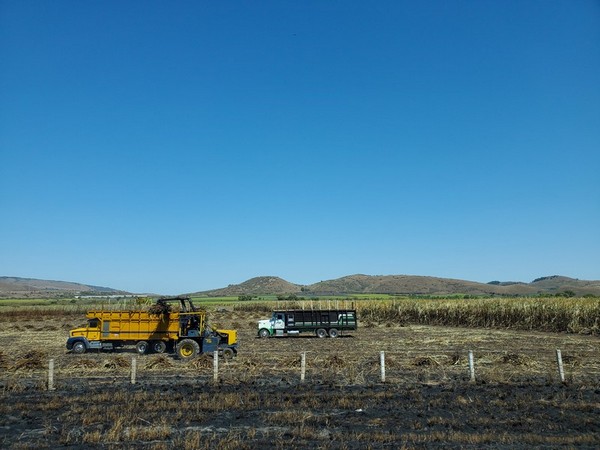
Sugarcane harvest
Celestino Gazca, Sinaloa

We spent two days at this campground on the beach near Mazatlan before heading to the border. (We also visited old friends Paul and Trish in Mazatlan but did not take a picture!)
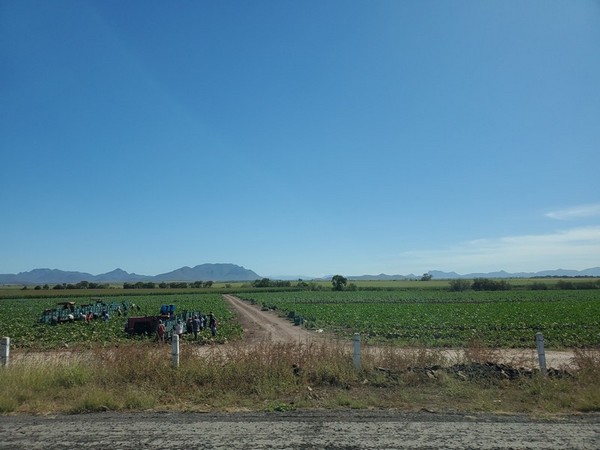
Sinaloa is like a winter garden for North America; their hard workers provide us with fresh vegetables in the winter.

Goodbye to Mexico until next year! Please keep your fingers crossed that Claudia gets elected in June. Morena is the progressive party that believes in taxing the rich to help reduce the wealth gap. They've been in power for six years and have made great progress in reducing poverty in Mexico. [She won!]
Back in the U.S.
On our trek north we visited family and friends in Arizona, California, and Oregon.

Dinner at my mom's winter condo in Scottsdale, Arizona, with my mom, brother Mark, sister-in-law Denise, and my mom's cousin John, visiting from New York.
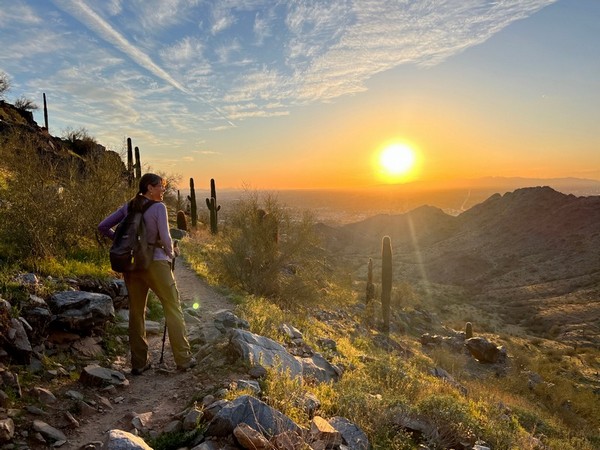
My brother Mark took me on a gorgeous four-mile hike around Piestewa Peak, in the Phoenix Mountains Preserve near Scottsdale.
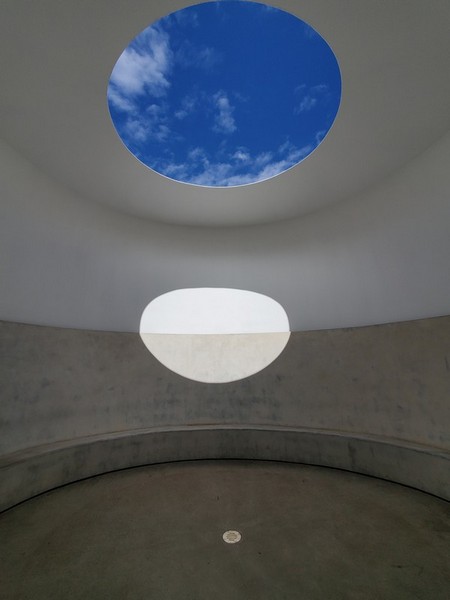
Old Town Scottsdale is a great place to explore, with lots of public art and beautiful pedestrian plazas. This is the ethereal "Knight Rise" art installation at the Scottsdale Museum of Contemporary Art. An elliptical opening in the roof creates light shapes that change with the weather and time of day.

Lunch in Scottsdale with second cousin Joan and her son and granddaughter. My genealogy research has allowed me to find many long lost relatives and learn their stories.
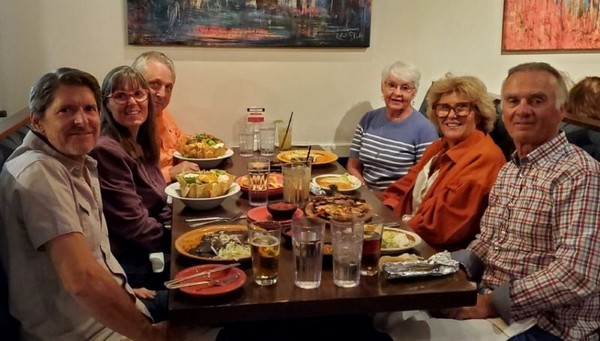
Dinner in Scottsdale with my brother Mark (left), my mom (in blue), my second cousin Nancy, and her husband.
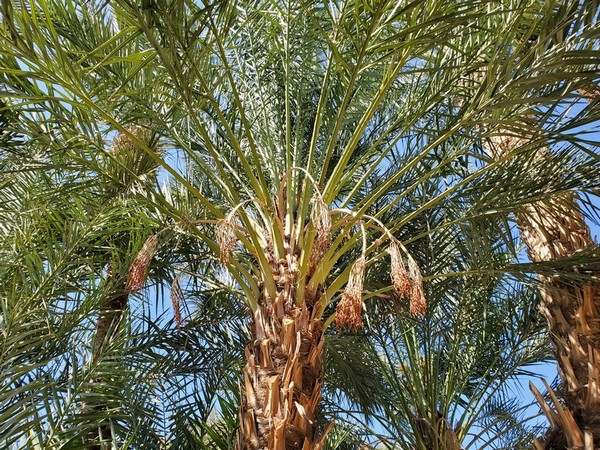
At Shield's in Indio, California, we sampled date ice cream (delicious) and learned how dates are grown and harvested. These are hanging clusters of baby dates on a female palm tree.

We visited Grant's cousin Gretchen in Redlands, California.
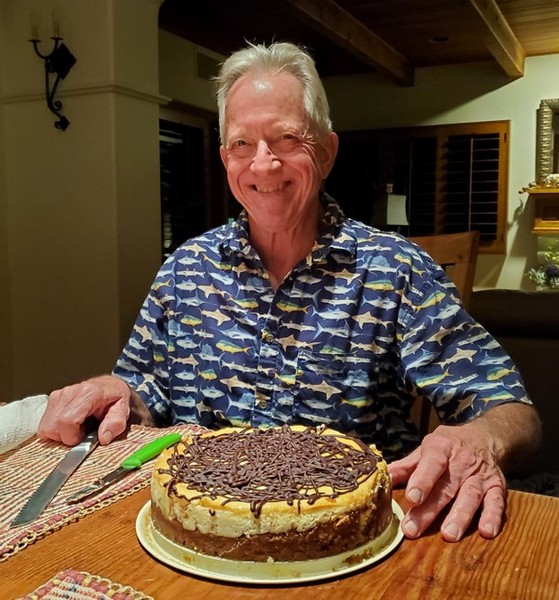
Grant's cousin Rudy (Gretchen's brother) baked this amazing cheesecake with lemon curd topping (from his Meyer lemons) and chocolate drizzle. I am nuts about cheesecake, and this was one of the best I've ever had.

We had a wonderful, too-short visit with brother David, wife Annie, and daughter Ava in Burbank.
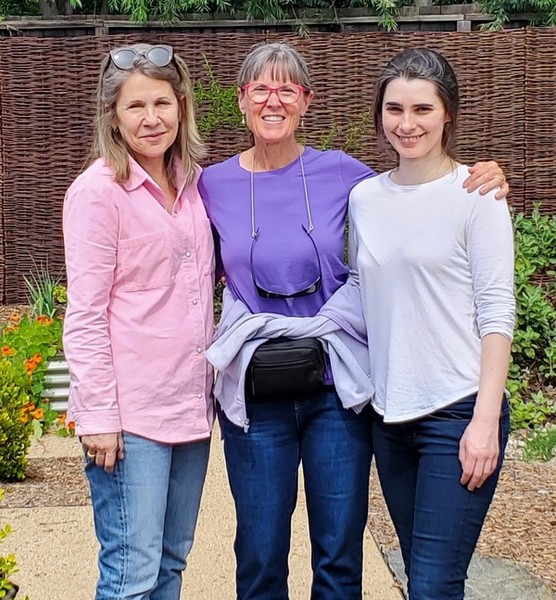
Visiting my second cousin, Cat, a college educator, and her daughter, Maria, in Pasadena.
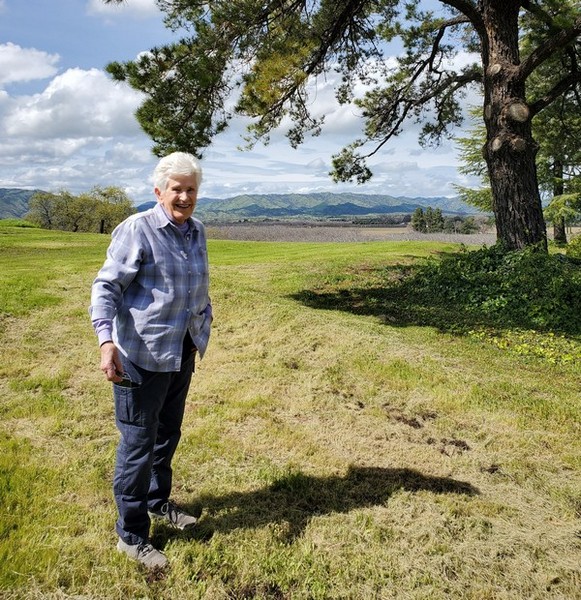
My second cousin Kathleen gave me a tour of her property in Winters, California.
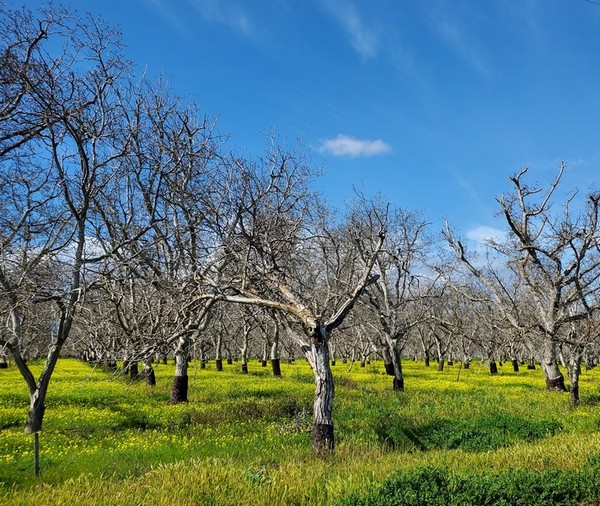
Yellow mustard blooming in a walnut orchard in Winters, California.
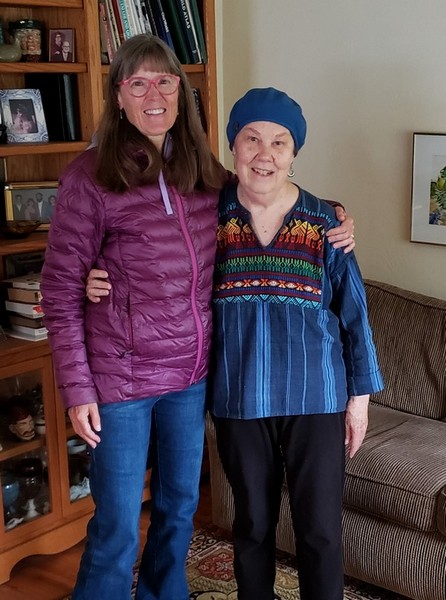
We visited Mexico friends Marilyn and Al at their home in Eugene, Oregon. They traveled in Mexico for decades, and boy do they have stories to tell!
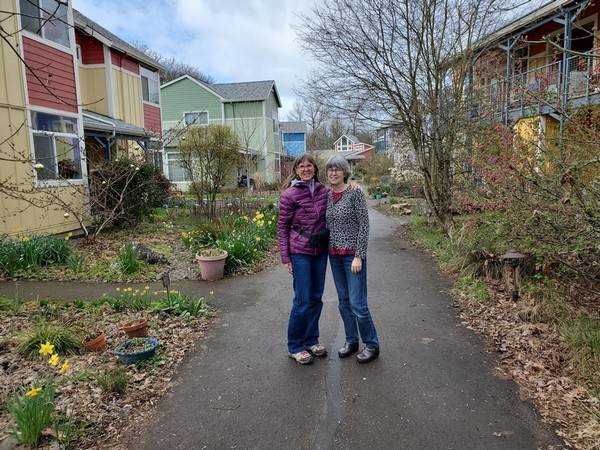
In Corvallis, Oregon, we visited Peace Corps friend Anne at the cohousing she helped found and has lived in for 16 years.
Click here to see our other travelogues.
Trip Costs
Our cost per day was about 25% more than last year because the exchange rate was less favorable (17 pesos to the dollar vs. 20 last year), and Mexico tolls and campground prices were higher. Gas was about the same average cost per gallon as last year (more in Mexico, less in the US).
Our total costs were $5292 for 75 days ($71/day). Some of our expenses, such as food, would be incurred if we stayed home, so our actual cost of taking this trip was closer to $3500.
Gas was $1724 (7755 miles at an average of about $4 per gallon; our van gets about 18 miles per gallon).
Camping was $875 (47 nights paid camping at an average of $18 a night).
Mexico road tolls were $407.
Mexico car insurance was $506 (it was cheaper to buy a 6-month policy than two one-month policies). We turn off the U.S. insurance on our vehicles when we're gone, which helps offset the cost of the Mexico insurance.
The remaining $1780 ($24 per day) covered groceries, restaurants, supplies, entrance fees, and $50 in souvenirs.